Market Potentiality of Tassal Group Limited in Japan and South Korea
VerifiedAdded on 2023/04/04
|22
|4907
|484
AI Summary
This paper analyzes the market potentiality of Tassal Group Limited's meat or seafood products in Japan and South Korea. It includes a company and product analysis, comparative country and product market attractiveness, competitor analysis, buyer analysis, market selection with justification, and entry strategy.
Contribute Materials
Your contribution can guide someone’s learning journey. Share your
documents today.
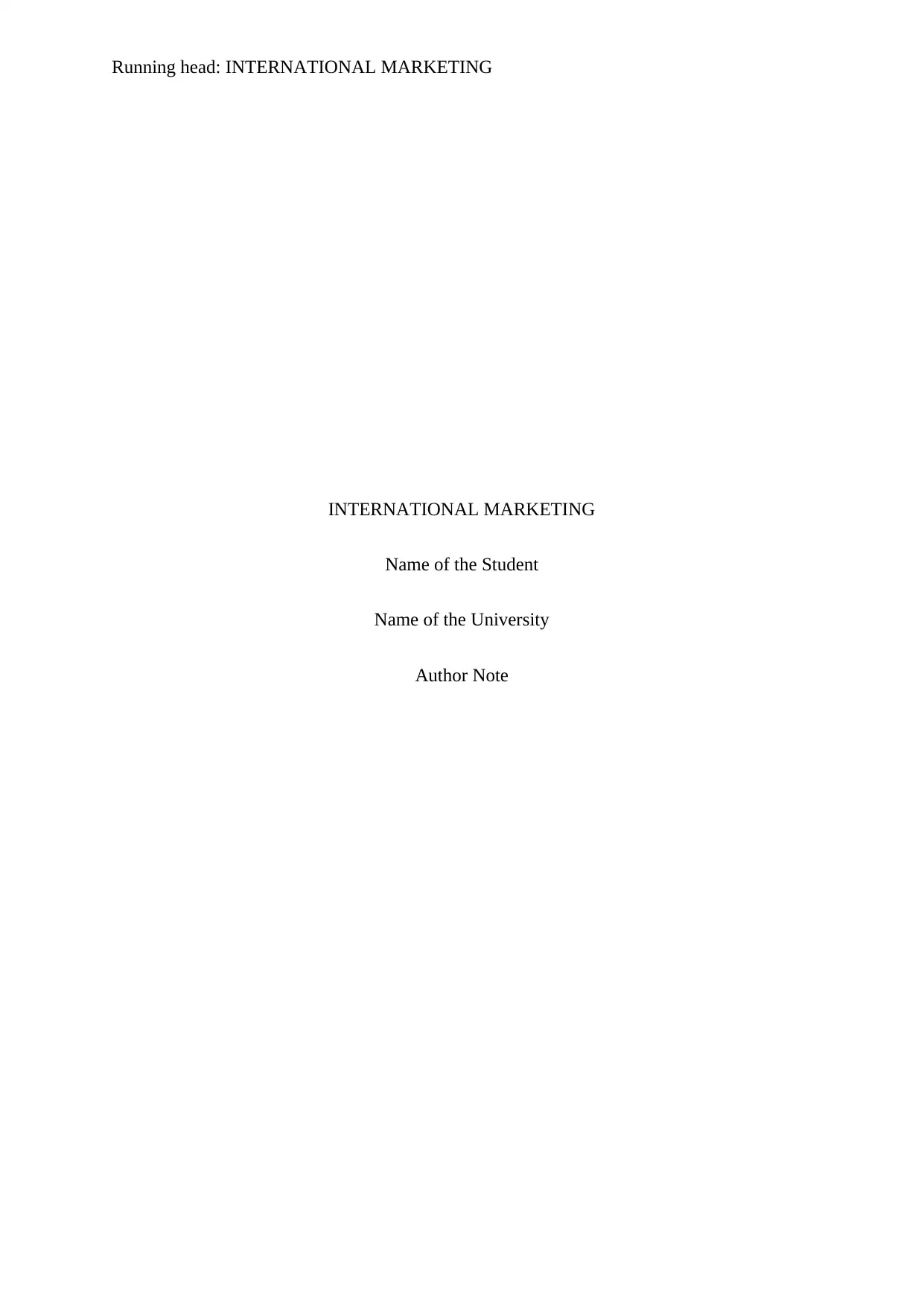
Running head: INTERNATIONAL MARKETING
INTERNATIONAL MARKETING
Name of the Student
Name of the University
Author Note
INTERNATIONAL MARKETING
Name of the Student
Name of the University
Author Note
Secure Best Marks with AI Grader
Need help grading? Try our AI Grader for instant feedback on your assignments.
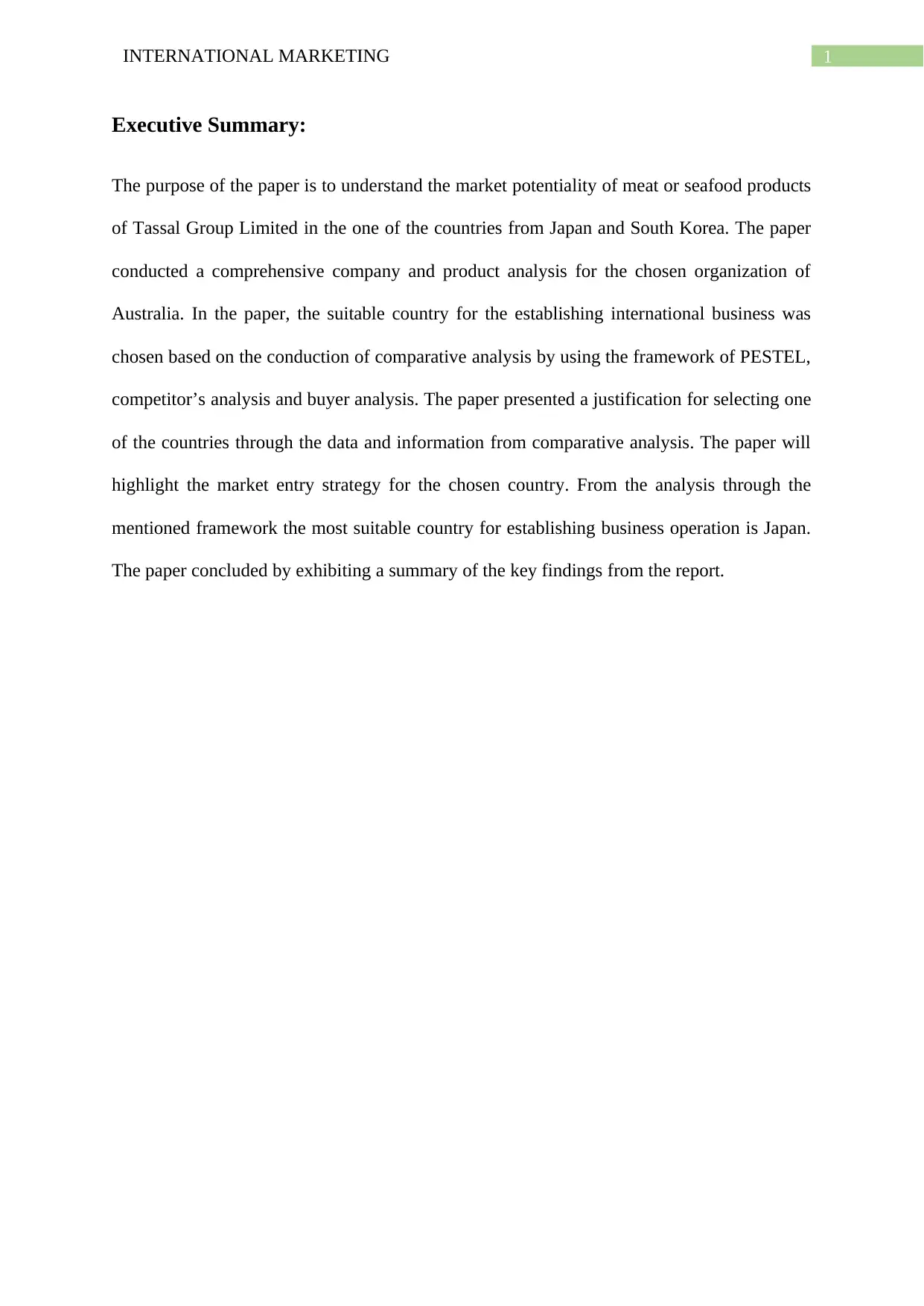
1INTERNATIONAL MARKETING
Executive Summary:
The purpose of the paper is to understand the market potentiality of meat or seafood products
of Tassal Group Limited in the one of the countries from Japan and South Korea. The paper
conducted a comprehensive company and product analysis for the chosen organization of
Australia. In the paper, the suitable country for the establishing international business was
chosen based on the conduction of comparative analysis by using the framework of PESTEL,
competitor’s analysis and buyer analysis. The paper presented a justification for selecting one
of the countries through the data and information from comparative analysis. The paper will
highlight the market entry strategy for the chosen country. From the analysis through the
mentioned framework the most suitable country for establishing business operation is Japan.
The paper concluded by exhibiting a summary of the key findings from the report.
Executive Summary:
The purpose of the paper is to understand the market potentiality of meat or seafood products
of Tassal Group Limited in the one of the countries from Japan and South Korea. The paper
conducted a comprehensive company and product analysis for the chosen organization of
Australia. In the paper, the suitable country for the establishing international business was
chosen based on the conduction of comparative analysis by using the framework of PESTEL,
competitor’s analysis and buyer analysis. The paper presented a justification for selecting one
of the countries through the data and information from comparative analysis. The paper will
highlight the market entry strategy for the chosen country. From the analysis through the
mentioned framework the most suitable country for establishing business operation is Japan.
The paper concluded by exhibiting a summary of the key findings from the report.
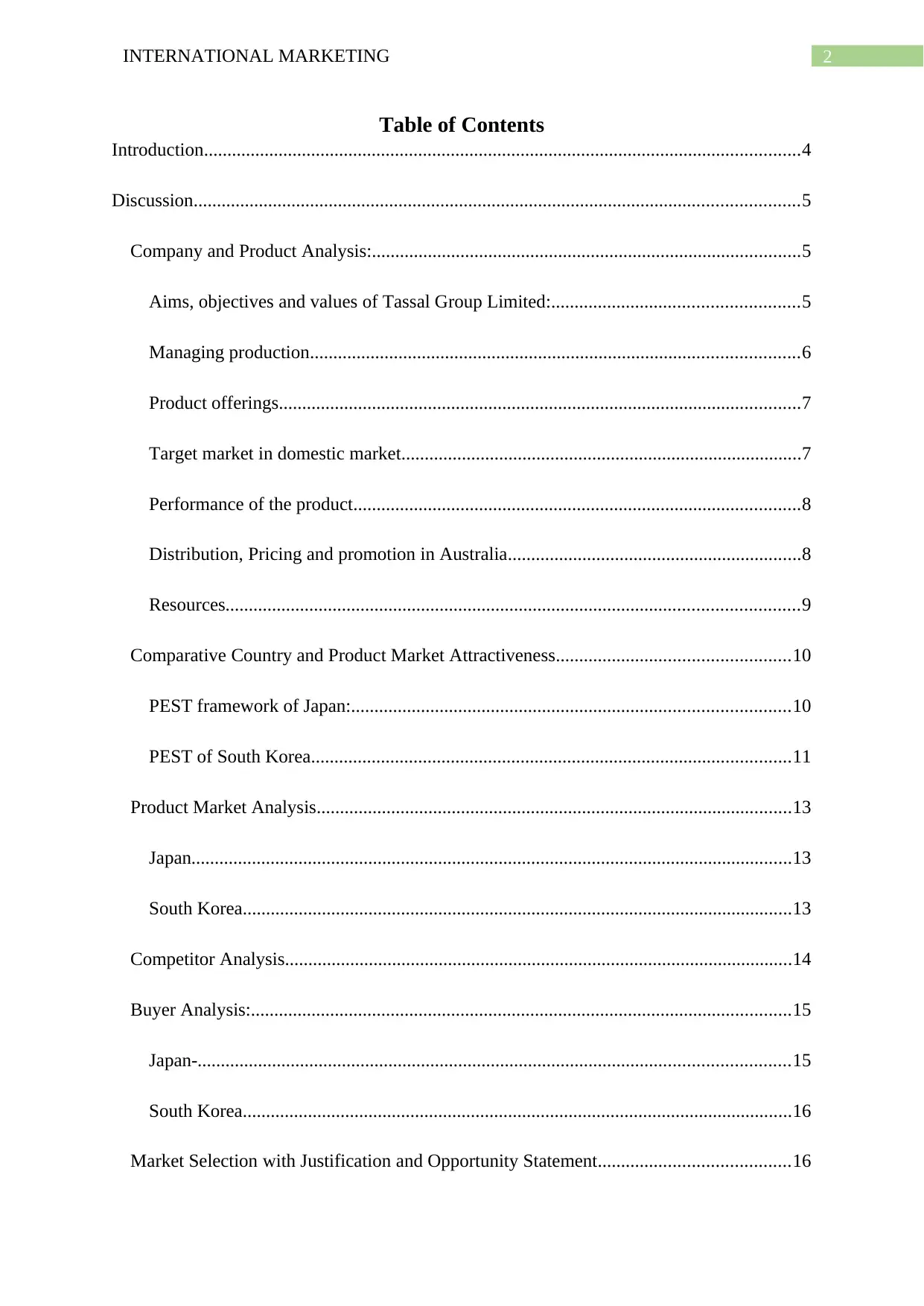
2INTERNATIONAL MARKETING
Table of Contents
Introduction................................................................................................................................4
Discussion..................................................................................................................................5
Company and Product Analysis:............................................................................................5
Aims, objectives and values of Tassal Group Limited:.....................................................5
Managing production.........................................................................................................6
Product offerings................................................................................................................7
Target market in domestic market......................................................................................7
Performance of the product................................................................................................8
Distribution, Pricing and promotion in Australia...............................................................8
Resources...........................................................................................................................9
Comparative Country and Product Market Attractiveness..................................................10
PEST framework of Japan:..............................................................................................10
PEST of South Korea.......................................................................................................11
Product Market Analysis......................................................................................................13
Japan.................................................................................................................................13
South Korea......................................................................................................................13
Competitor Analysis.............................................................................................................14
Buyer Analysis:....................................................................................................................15
Japan-...............................................................................................................................15
South Korea......................................................................................................................16
Market Selection with Justification and Opportunity Statement.........................................16
Table of Contents
Introduction................................................................................................................................4
Discussion..................................................................................................................................5
Company and Product Analysis:............................................................................................5
Aims, objectives and values of Tassal Group Limited:.....................................................5
Managing production.........................................................................................................6
Product offerings................................................................................................................7
Target market in domestic market......................................................................................7
Performance of the product................................................................................................8
Distribution, Pricing and promotion in Australia...............................................................8
Resources...........................................................................................................................9
Comparative Country and Product Market Attractiveness..................................................10
PEST framework of Japan:..............................................................................................10
PEST of South Korea.......................................................................................................11
Product Market Analysis......................................................................................................13
Japan.................................................................................................................................13
South Korea......................................................................................................................13
Competitor Analysis.............................................................................................................14
Buyer Analysis:....................................................................................................................15
Japan-...............................................................................................................................15
South Korea......................................................................................................................16
Market Selection with Justification and Opportunity Statement.........................................16

3INTERNATIONAL MARKETING
Entry Strategy:.....................................................................................................................17
Conclusion................................................................................................................................17
Entry Strategy:.....................................................................................................................17
Conclusion................................................................................................................................17
Secure Best Marks with AI Grader
Need help grading? Try our AI Grader for instant feedback on your assignments.
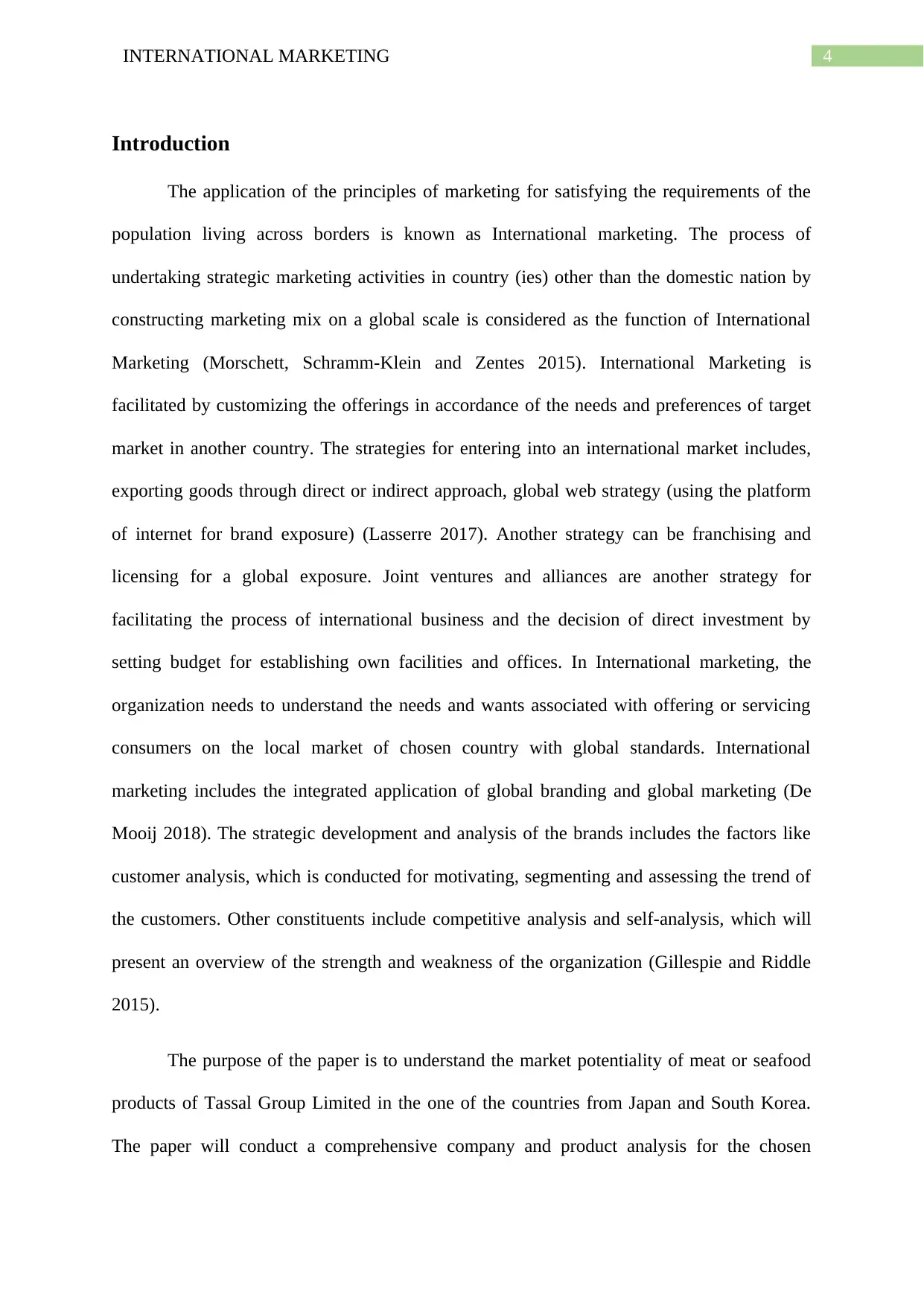
4INTERNATIONAL MARKETING
Introduction
The application of the principles of marketing for satisfying the requirements of the
population living across borders is known as International marketing. The process of
undertaking strategic marketing activities in country (ies) other than the domestic nation by
constructing marketing mix on a global scale is considered as the function of International
Marketing (Morschett, Schramm-Klein and Zentes 2015). International Marketing is
facilitated by customizing the offerings in accordance of the needs and preferences of target
market in another country. The strategies for entering into an international market includes,
exporting goods through direct or indirect approach, global web strategy (using the platform
of internet for brand exposure) (Lasserre 2017). Another strategy can be franchising and
licensing for a global exposure. Joint ventures and alliances are another strategy for
facilitating the process of international business and the decision of direct investment by
setting budget for establishing own facilities and offices. In International marketing, the
organization needs to understand the needs and wants associated with offering or servicing
consumers on the local market of chosen country with global standards. International
marketing includes the integrated application of global branding and global marketing (De
Mooij 2018). The strategic development and analysis of the brands includes the factors like
customer analysis, which is conducted for motivating, segmenting and assessing the trend of
the customers. Other constituents include competitive analysis and self-analysis, which will
present an overview of the strength and weakness of the organization (Gillespie and Riddle
2015).
The purpose of the paper is to understand the market potentiality of meat or seafood
products of Tassal Group Limited in the one of the countries from Japan and South Korea.
The paper will conduct a comprehensive company and product analysis for the chosen
Introduction
The application of the principles of marketing for satisfying the requirements of the
population living across borders is known as International marketing. The process of
undertaking strategic marketing activities in country (ies) other than the domestic nation by
constructing marketing mix on a global scale is considered as the function of International
Marketing (Morschett, Schramm-Klein and Zentes 2015). International Marketing is
facilitated by customizing the offerings in accordance of the needs and preferences of target
market in another country. The strategies for entering into an international market includes,
exporting goods through direct or indirect approach, global web strategy (using the platform
of internet for brand exposure) (Lasserre 2017). Another strategy can be franchising and
licensing for a global exposure. Joint ventures and alliances are another strategy for
facilitating the process of international business and the decision of direct investment by
setting budget for establishing own facilities and offices. In International marketing, the
organization needs to understand the needs and wants associated with offering or servicing
consumers on the local market of chosen country with global standards. International
marketing includes the integrated application of global branding and global marketing (De
Mooij 2018). The strategic development and analysis of the brands includes the factors like
customer analysis, which is conducted for motivating, segmenting and assessing the trend of
the customers. Other constituents include competitive analysis and self-analysis, which will
present an overview of the strength and weakness of the organization (Gillespie and Riddle
2015).
The purpose of the paper is to understand the market potentiality of meat or seafood
products of Tassal Group Limited in the one of the countries from Japan and South Korea.
The paper will conduct a comprehensive company and product analysis for the chosen
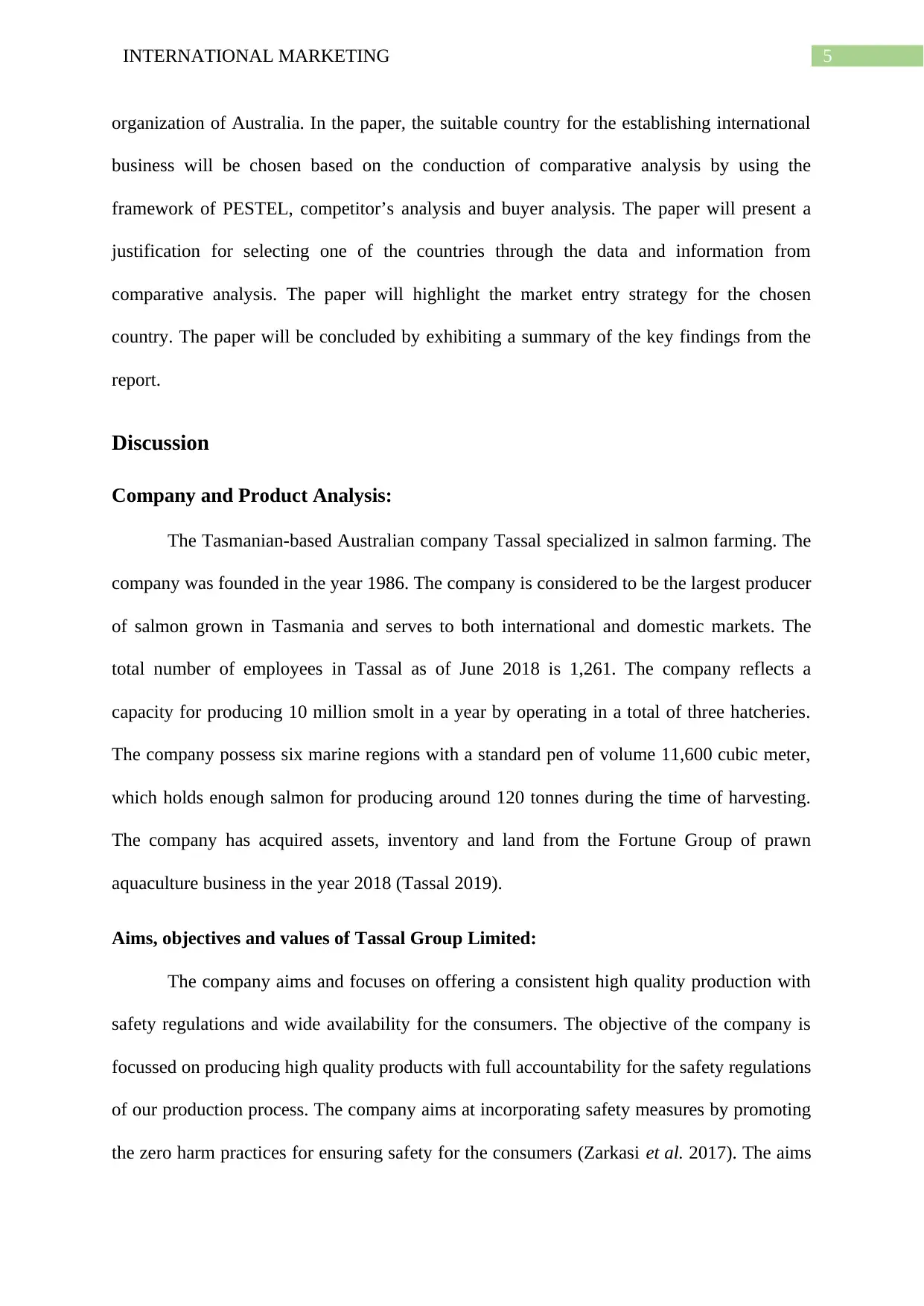
5INTERNATIONAL MARKETING
organization of Australia. In the paper, the suitable country for the establishing international
business will be chosen based on the conduction of comparative analysis by using the
framework of PESTEL, competitor’s analysis and buyer analysis. The paper will present a
justification for selecting one of the countries through the data and information from
comparative analysis. The paper will highlight the market entry strategy for the chosen
country. The paper will be concluded by exhibiting a summary of the key findings from the
report.
Discussion
Company and Product Analysis:
The Tasmanian-based Australian company Tassal specialized in salmon farming. The
company was founded in the year 1986. The company is considered to be the largest producer
of salmon grown in Tasmania and serves to both international and domestic markets. The
total number of employees in Tassal as of June 2018 is 1,261. The company reflects a
capacity for producing 10 million smolt in a year by operating in a total of three hatcheries.
The company possess six marine regions with a standard pen of volume 11,600 cubic meter,
which holds enough salmon for producing around 120 tonnes during the time of harvesting.
The company has acquired assets, inventory and land from the Fortune Group of prawn
aquaculture business in the year 2018 (Tassal 2019).
Aims, objectives and values of Tassal Group Limited:
The company aims and focuses on offering a consistent high quality production with
safety regulations and wide availability for the consumers. The objective of the company is
focussed on producing high quality products with full accountability for the safety regulations
of our production process. The company aims at incorporating safety measures by promoting
the zero harm practices for ensuring safety for the consumers (Zarkasi et al. 2017). The aims
organization of Australia. In the paper, the suitable country for the establishing international
business will be chosen based on the conduction of comparative analysis by using the
framework of PESTEL, competitor’s analysis and buyer analysis. The paper will present a
justification for selecting one of the countries through the data and information from
comparative analysis. The paper will highlight the market entry strategy for the chosen
country. The paper will be concluded by exhibiting a summary of the key findings from the
report.
Discussion
Company and Product Analysis:
The Tasmanian-based Australian company Tassal specialized in salmon farming. The
company was founded in the year 1986. The company is considered to be the largest producer
of salmon grown in Tasmania and serves to both international and domestic markets. The
total number of employees in Tassal as of June 2018 is 1,261. The company reflects a
capacity for producing 10 million smolt in a year by operating in a total of three hatcheries.
The company possess six marine regions with a standard pen of volume 11,600 cubic meter,
which holds enough salmon for producing around 120 tonnes during the time of harvesting.
The company has acquired assets, inventory and land from the Fortune Group of prawn
aquaculture business in the year 2018 (Tassal 2019).
Aims, objectives and values of Tassal Group Limited:
The company aims and focuses on offering a consistent high quality production with
safety regulations and wide availability for the consumers. The objective of the company is
focussed on producing high quality products with full accountability for the safety regulations
of our production process. The company aims at incorporating safety measures by promoting
the zero harm practices for ensuring safety for the consumers (Zarkasi et al. 2017). The aims
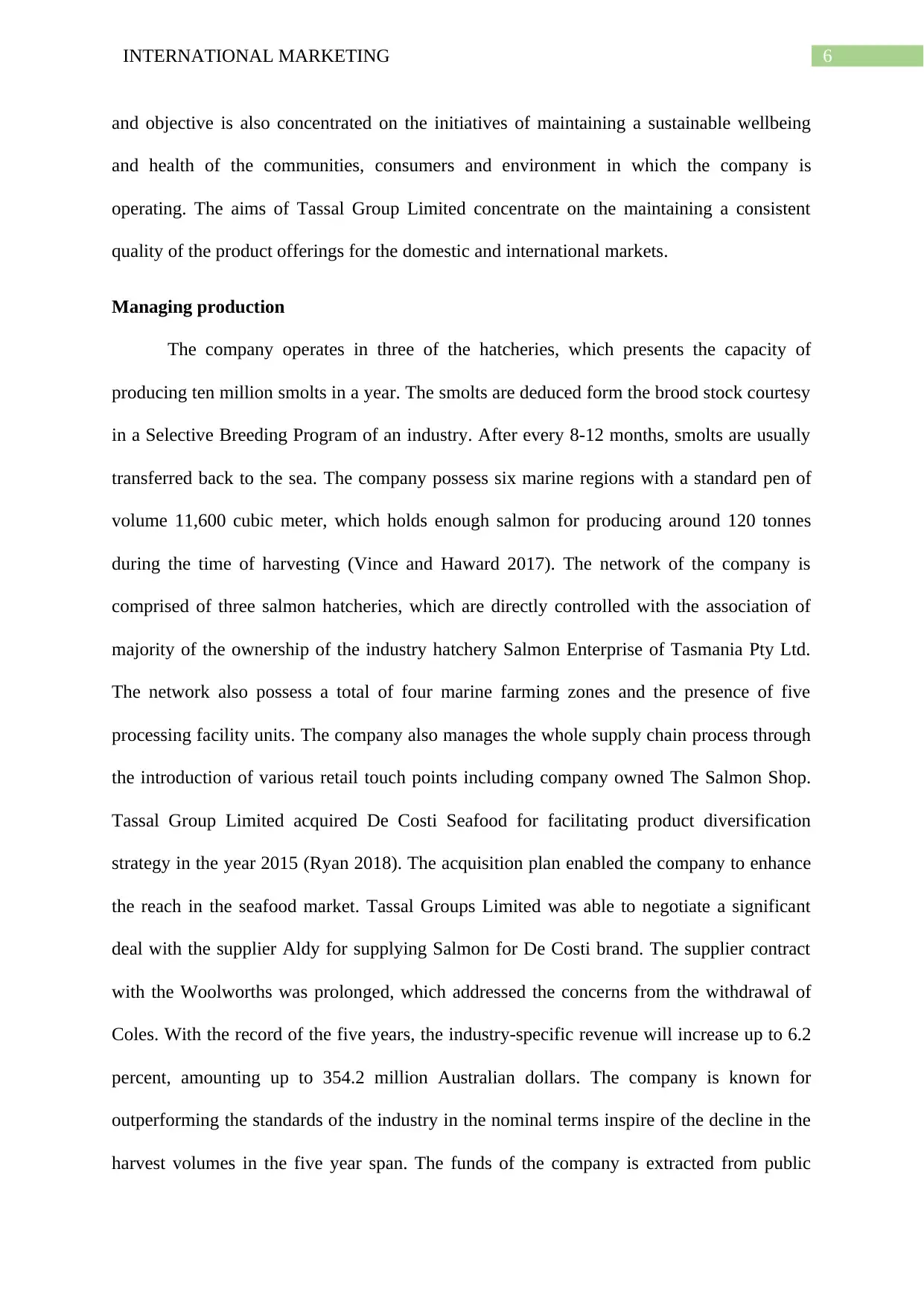
6INTERNATIONAL MARKETING
and objective is also concentrated on the initiatives of maintaining a sustainable wellbeing
and health of the communities, consumers and environment in which the company is
operating. The aims of Tassal Group Limited concentrate on the maintaining a consistent
quality of the product offerings for the domestic and international markets.
Managing production
The company operates in three of the hatcheries, which presents the capacity of
producing ten million smolts in a year. The smolts are deduced form the brood stock courtesy
in a Selective Breeding Program of an industry. After every 8-12 months, smolts are usually
transferred back to the sea. The company possess six marine regions with a standard pen of
volume 11,600 cubic meter, which holds enough salmon for producing around 120 tonnes
during the time of harvesting (Vince and Haward 2017). The network of the company is
comprised of three salmon hatcheries, which are directly controlled with the association of
majority of the ownership of the industry hatchery Salmon Enterprise of Tasmania Pty Ltd.
The network also possess a total of four marine farming zones and the presence of five
processing facility units. The company also manages the whole supply chain process through
the introduction of various retail touch points including company owned The Salmon Shop.
Tassal Group Limited acquired De Costi Seafood for facilitating product diversification
strategy in the year 2015 (Ryan 2018). The acquisition plan enabled the company to enhance
the reach in the seafood market. Tassal Groups Limited was able to negotiate a significant
deal with the supplier Aldy for supplying Salmon for De Costi brand. The supplier contract
with the Woolworths was prolonged, which addressed the concerns from the withdrawal of
Coles. With the record of the five years, the industry-specific revenue will increase up to 6.2
percent, amounting up to 354.2 million Australian dollars. The company is known for
outperforming the standards of the industry in the nominal terms inspire of the decline in the
harvest volumes in the five year span. The funds of the company is extracted from public
and objective is also concentrated on the initiatives of maintaining a sustainable wellbeing
and health of the communities, consumers and environment in which the company is
operating. The aims of Tassal Group Limited concentrate on the maintaining a consistent
quality of the product offerings for the domestic and international markets.
Managing production
The company operates in three of the hatcheries, which presents the capacity of
producing ten million smolts in a year. The smolts are deduced form the brood stock courtesy
in a Selective Breeding Program of an industry. After every 8-12 months, smolts are usually
transferred back to the sea. The company possess six marine regions with a standard pen of
volume 11,600 cubic meter, which holds enough salmon for producing around 120 tonnes
during the time of harvesting (Vince and Haward 2017). The network of the company is
comprised of three salmon hatcheries, which are directly controlled with the association of
majority of the ownership of the industry hatchery Salmon Enterprise of Tasmania Pty Ltd.
The network also possess a total of four marine farming zones and the presence of five
processing facility units. The company also manages the whole supply chain process through
the introduction of various retail touch points including company owned The Salmon Shop.
Tassal Group Limited acquired De Costi Seafood for facilitating product diversification
strategy in the year 2015 (Ryan 2018). The acquisition plan enabled the company to enhance
the reach in the seafood market. Tassal Groups Limited was able to negotiate a significant
deal with the supplier Aldy for supplying Salmon for De Costi brand. The supplier contract
with the Woolworths was prolonged, which addressed the concerns from the withdrawal of
Coles. With the record of the five years, the industry-specific revenue will increase up to 6.2
percent, amounting up to 354.2 million Australian dollars. The company is known for
outperforming the standards of the industry in the nominal terms inspire of the decline in the
harvest volumes in the five year span. The funds of the company is extracted from public
Paraphrase This Document
Need a fresh take? Get an instant paraphrase of this document with our AI Paraphraser
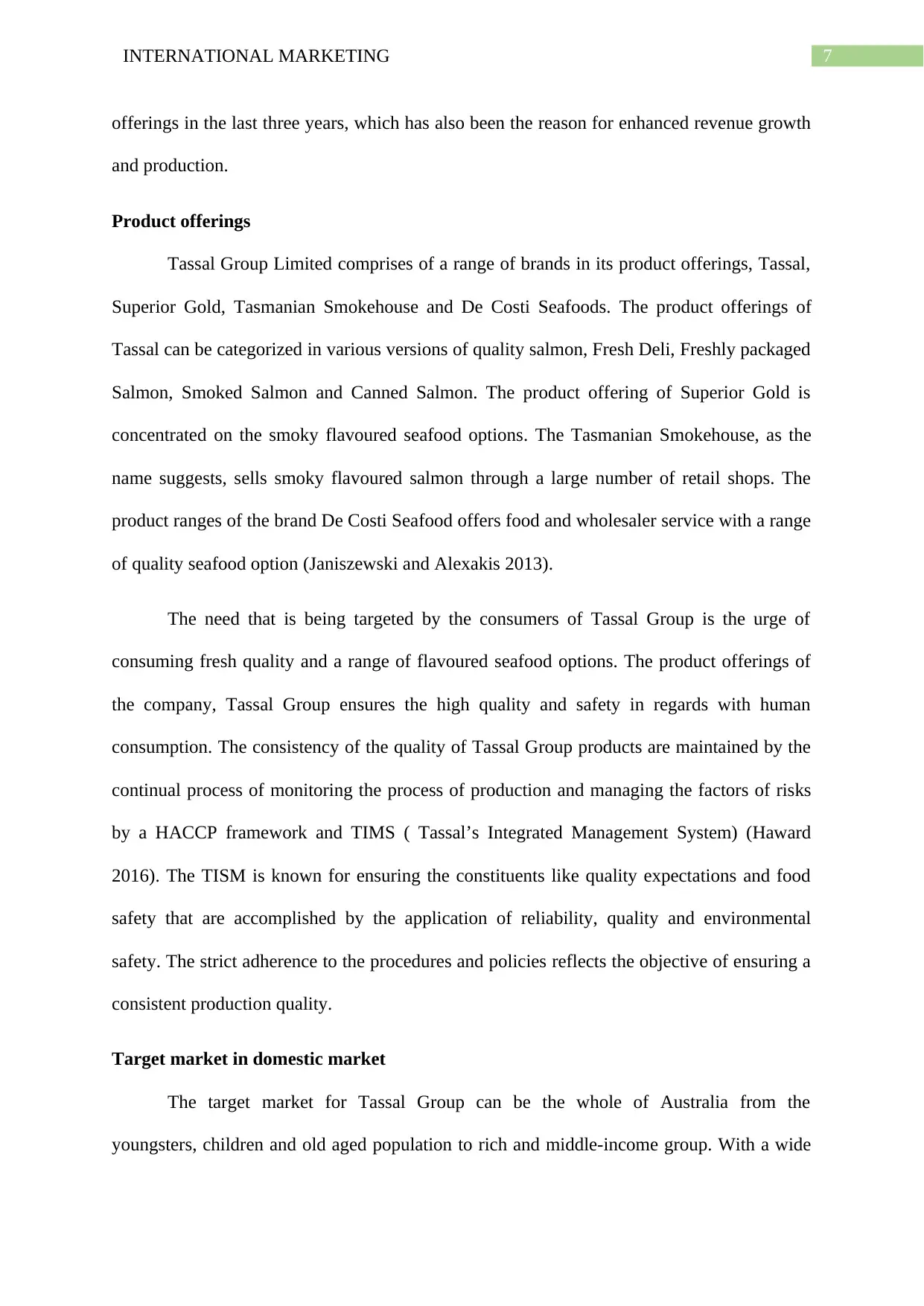
7INTERNATIONAL MARKETING
offerings in the last three years, which has also been the reason for enhanced revenue growth
and production.
Product offerings
Tassal Group Limited comprises of a range of brands in its product offerings, Tassal,
Superior Gold, Tasmanian Smokehouse and De Costi Seafoods. The product offerings of
Tassal can be categorized in various versions of quality salmon, Fresh Deli, Freshly packaged
Salmon, Smoked Salmon and Canned Salmon. The product offering of Superior Gold is
concentrated on the smoky flavoured seafood options. The Tasmanian Smokehouse, as the
name suggests, sells smoky flavoured salmon through a large number of retail shops. The
product ranges of the brand De Costi Seafood offers food and wholesaler service with a range
of quality seafood option (Janiszewski and Alexakis 2013).
The need that is being targeted by the consumers of Tassal Group is the urge of
consuming fresh quality and a range of flavoured seafood options. The product offerings of
the company, Tassal Group ensures the high quality and safety in regards with human
consumption. The consistency of the quality of Tassal Group products are maintained by the
continual process of monitoring the process of production and managing the factors of risks
by a HACCP framework and TIMS ( Tassal’s Integrated Management System) (Haward
2016). The TISM is known for ensuring the constituents like quality expectations and food
safety that are accomplished by the application of reliability, quality and environmental
safety. The strict adherence to the procedures and policies reflects the objective of ensuring a
consistent production quality.
Target market in domestic market
The target market for Tassal Group can be the whole of Australia from the
youngsters, children and old aged population to rich and middle-income group. With a wide
offerings in the last three years, which has also been the reason for enhanced revenue growth
and production.
Product offerings
Tassal Group Limited comprises of a range of brands in its product offerings, Tassal,
Superior Gold, Tasmanian Smokehouse and De Costi Seafoods. The product offerings of
Tassal can be categorized in various versions of quality salmon, Fresh Deli, Freshly packaged
Salmon, Smoked Salmon and Canned Salmon. The product offering of Superior Gold is
concentrated on the smoky flavoured seafood options. The Tasmanian Smokehouse, as the
name suggests, sells smoky flavoured salmon through a large number of retail shops. The
product ranges of the brand De Costi Seafood offers food and wholesaler service with a range
of quality seafood option (Janiszewski and Alexakis 2013).
The need that is being targeted by the consumers of Tassal Group is the urge of
consuming fresh quality and a range of flavoured seafood options. The product offerings of
the company, Tassal Group ensures the high quality and safety in regards with human
consumption. The consistency of the quality of Tassal Group products are maintained by the
continual process of monitoring the process of production and managing the factors of risks
by a HACCP framework and TIMS ( Tassal’s Integrated Management System) (Haward
2016). The TISM is known for ensuring the constituents like quality expectations and food
safety that are accomplished by the application of reliability, quality and environmental
safety. The strict adherence to the procedures and policies reflects the objective of ensuring a
consistent production quality.
Target market in domestic market
The target market for Tassal Group can be the whole of Australia from the
youngsters, children and old aged population to rich and middle-income group. With a wide

8INTERNATIONAL MARKETING
range of products offered by the brands of Tassal Group, the company can target every
segment of the market. An interesting range of smoked and flavoured sea food option
presents an opportunity to target the occupational segment of the population. Family size is
another segment, which is targeted for the purpose of offering the discounted packages for
the families in Australia (Cucchiara, Kwon and Ha 2015).
Performance of the product
The industry-concentrated revenue of Tassal Group for the year 2016-2017
experienced an improvement of 6.2 percent, amounting up to 354.2 million dollars. This
figure was excluding the revenue from its brand De Costi, which operates in both seafood
wholesaling and fish business segment. The performance of the quality product of Tassal
outperformed the standards of the industry in spite of the decreasing harvest volumes in the
last five years.
Distribution, Pricing and promotion in Australia
The salmon ranges of Tassal Group is made available or distributed from the
restaurants (retail point), popular fish markets and supermarkets in the home country,
Australia. With the wide distribution channel network, Tassal Group is considered to be the
largest supplier of the fresh and smoked salmon ranges in the supermarkets of Australia. The
majority of the revenue of the company is deduced from distribution channel, wholesalers
and the operators of food services. The revenue from food service operators and wholesalers
amounts up to 60 percent of the total revenue in Australia whereas the rest 40 percent is
derived from the retail outlets and the supermarkets. The distribution channels are mainly
concentrated on selling majority of the product ranges to the potential customers of Victoria
and New South Wales. The network comprises of four marine zones of farming, five
processing units, three salmon hatcheries which are directly controlled by the company, retail
points of around 3,375 and a very popular own retail outlet dedicated to selling the products
range of products offered by the brands of Tassal Group, the company can target every
segment of the market. An interesting range of smoked and flavoured sea food option
presents an opportunity to target the occupational segment of the population. Family size is
another segment, which is targeted for the purpose of offering the discounted packages for
the families in Australia (Cucchiara, Kwon and Ha 2015).
Performance of the product
The industry-concentrated revenue of Tassal Group for the year 2016-2017
experienced an improvement of 6.2 percent, amounting up to 354.2 million dollars. This
figure was excluding the revenue from its brand De Costi, which operates in both seafood
wholesaling and fish business segment. The performance of the quality product of Tassal
outperformed the standards of the industry in spite of the decreasing harvest volumes in the
last five years.
Distribution, Pricing and promotion in Australia
The salmon ranges of Tassal Group is made available or distributed from the
restaurants (retail point), popular fish markets and supermarkets in the home country,
Australia. With the wide distribution channel network, Tassal Group is considered to be the
largest supplier of the fresh and smoked salmon ranges in the supermarkets of Australia. The
majority of the revenue of the company is deduced from distribution channel, wholesalers
and the operators of food services. The revenue from food service operators and wholesalers
amounts up to 60 percent of the total revenue in Australia whereas the rest 40 percent is
derived from the retail outlets and the supermarkets. The distribution channels are mainly
concentrated on selling majority of the product ranges to the potential customers of Victoria
and New South Wales. The network comprises of four marine zones of farming, five
processing units, three salmon hatcheries which are directly controlled by the company, retail
points of around 3,375 and a very popular own retail outlet dedicated to selling the products
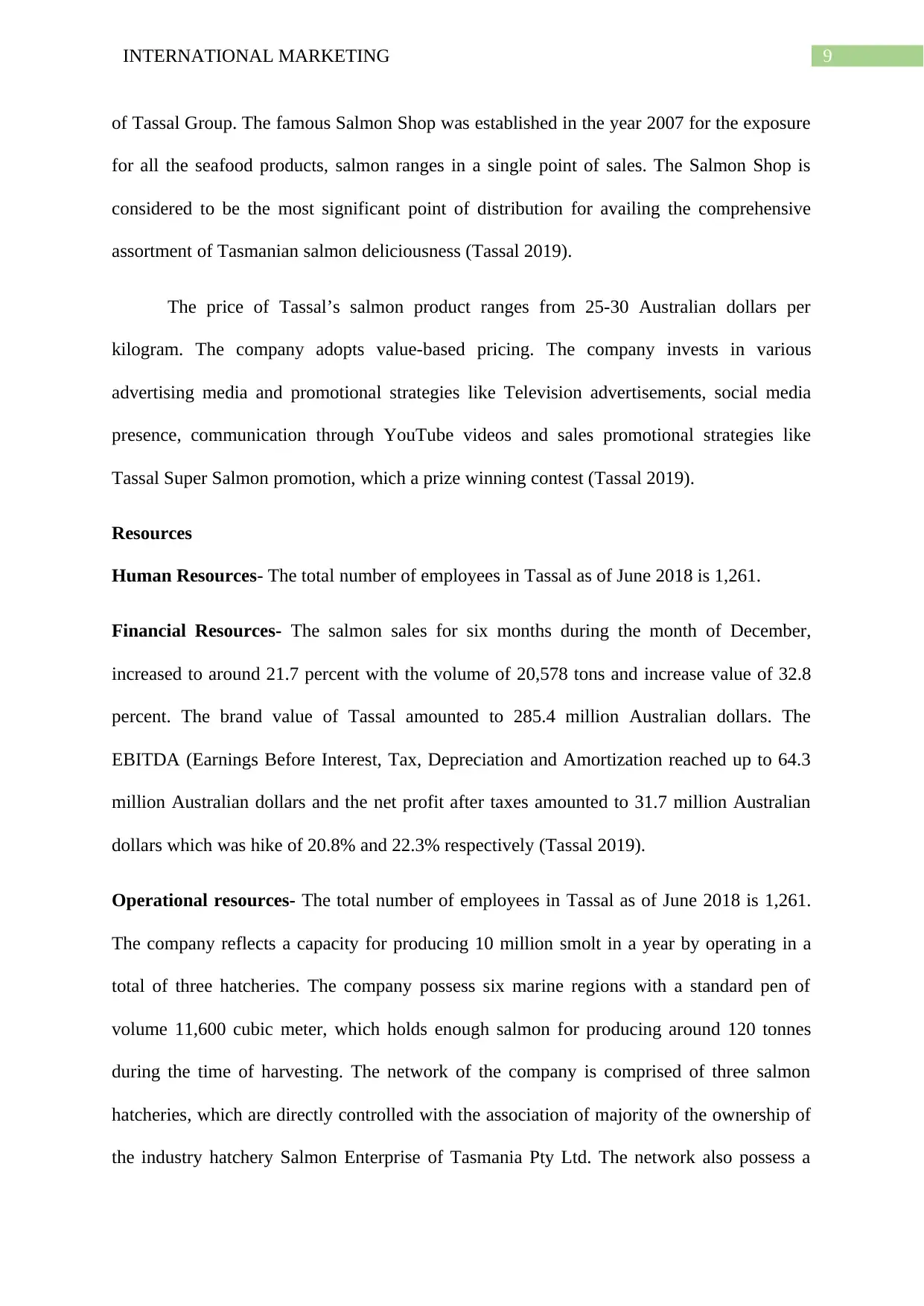
9INTERNATIONAL MARKETING
of Tassal Group. The famous Salmon Shop was established in the year 2007 for the exposure
for all the seafood products, salmon ranges in a single point of sales. The Salmon Shop is
considered to be the most significant point of distribution for availing the comprehensive
assortment of Tasmanian salmon deliciousness (Tassal 2019).
The price of Tassal’s salmon product ranges from 25-30 Australian dollars per
kilogram. The company adopts value-based pricing. The company invests in various
advertising media and promotional strategies like Television advertisements, social media
presence, communication through YouTube videos and sales promotional strategies like
Tassal Super Salmon promotion, which a prize winning contest (Tassal 2019).
Resources
Human Resources- The total number of employees in Tassal as of June 2018 is 1,261.
Financial Resources- The salmon sales for six months during the month of December,
increased to around 21.7 percent with the volume of 20,578 tons and increase value of 32.8
percent. The brand value of Tassal amounted to 285.4 million Australian dollars. The
EBITDA (Earnings Before Interest, Tax, Depreciation and Amortization reached up to 64.3
million Australian dollars and the net profit after taxes amounted to 31.7 million Australian
dollars which was hike of 20.8% and 22.3% respectively (Tassal 2019).
Operational resources- The total number of employees in Tassal as of June 2018 is 1,261.
The company reflects a capacity for producing 10 million smolt in a year by operating in a
total of three hatcheries. The company possess six marine regions with a standard pen of
volume 11,600 cubic meter, which holds enough salmon for producing around 120 tonnes
during the time of harvesting. The network of the company is comprised of three salmon
hatcheries, which are directly controlled with the association of majority of the ownership of
the industry hatchery Salmon Enterprise of Tasmania Pty Ltd. The network also possess a
of Tassal Group. The famous Salmon Shop was established in the year 2007 for the exposure
for all the seafood products, salmon ranges in a single point of sales. The Salmon Shop is
considered to be the most significant point of distribution for availing the comprehensive
assortment of Tasmanian salmon deliciousness (Tassal 2019).
The price of Tassal’s salmon product ranges from 25-30 Australian dollars per
kilogram. The company adopts value-based pricing. The company invests in various
advertising media and promotional strategies like Television advertisements, social media
presence, communication through YouTube videos and sales promotional strategies like
Tassal Super Salmon promotion, which a prize winning contest (Tassal 2019).
Resources
Human Resources- The total number of employees in Tassal as of June 2018 is 1,261.
Financial Resources- The salmon sales for six months during the month of December,
increased to around 21.7 percent with the volume of 20,578 tons and increase value of 32.8
percent. The brand value of Tassal amounted to 285.4 million Australian dollars. The
EBITDA (Earnings Before Interest, Tax, Depreciation and Amortization reached up to 64.3
million Australian dollars and the net profit after taxes amounted to 31.7 million Australian
dollars which was hike of 20.8% and 22.3% respectively (Tassal 2019).
Operational resources- The total number of employees in Tassal as of June 2018 is 1,261.
The company reflects a capacity for producing 10 million smolt in a year by operating in a
total of three hatcheries. The company possess six marine regions with a standard pen of
volume 11,600 cubic meter, which holds enough salmon for producing around 120 tonnes
during the time of harvesting. The network of the company is comprised of three salmon
hatcheries, which are directly controlled with the association of majority of the ownership of
the industry hatchery Salmon Enterprise of Tasmania Pty Ltd. The network also possess a
Secure Best Marks with AI Grader
Need help grading? Try our AI Grader for instant feedback on your assignments.
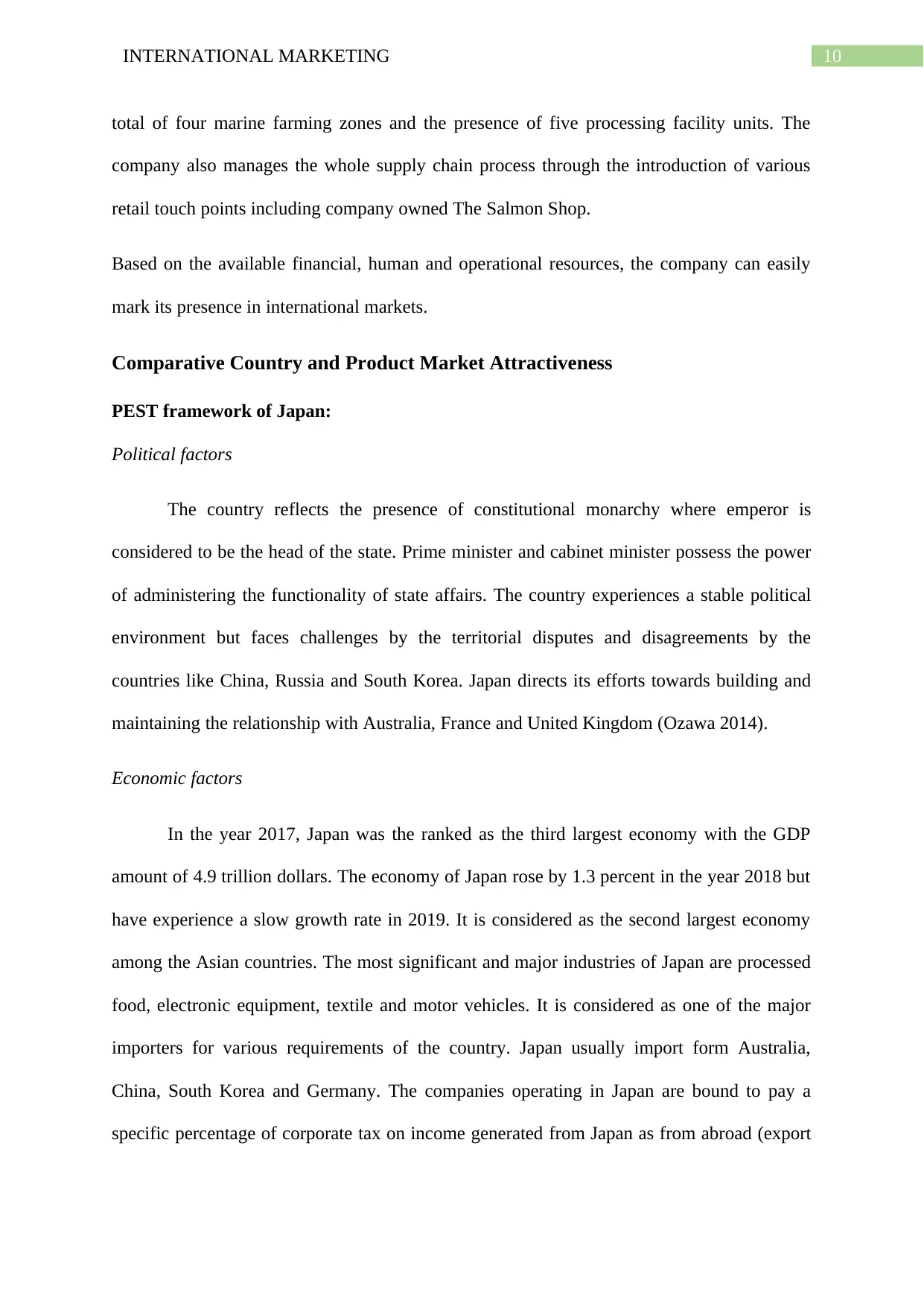
10INTERNATIONAL MARKETING
total of four marine farming zones and the presence of five processing facility units. The
company also manages the whole supply chain process through the introduction of various
retail touch points including company owned The Salmon Shop.
Based on the available financial, human and operational resources, the company can easily
mark its presence in international markets.
Comparative Country and Product Market Attractiveness
PEST framework of Japan:
Political factors
The country reflects the presence of constitutional monarchy where emperor is
considered to be the head of the state. Prime minister and cabinet minister possess the power
of administering the functionality of state affairs. The country experiences a stable political
environment but faces challenges by the territorial disputes and disagreements by the
countries like China, Russia and South Korea. Japan directs its efforts towards building and
maintaining the relationship with Australia, France and United Kingdom (Ozawa 2014).
Economic factors
In the year 2017, Japan was the ranked as the third largest economy with the GDP
amount of 4.9 trillion dollars. The economy of Japan rose by 1.3 percent in the year 2018 but
have experience a slow growth rate in 2019. It is considered as the second largest economy
among the Asian countries. The most significant and major industries of Japan are processed
food, electronic equipment, textile and motor vehicles. It is considered as one of the major
importers for various requirements of the country. Japan usually import form Australia,
China, South Korea and Germany. The companies operating in Japan are bound to pay a
specific percentage of corporate tax on income generated from Japan as from abroad (export
total of four marine farming zones and the presence of five processing facility units. The
company also manages the whole supply chain process through the introduction of various
retail touch points including company owned The Salmon Shop.
Based on the available financial, human and operational resources, the company can easily
mark its presence in international markets.
Comparative Country and Product Market Attractiveness
PEST framework of Japan:
Political factors
The country reflects the presence of constitutional monarchy where emperor is
considered to be the head of the state. Prime minister and cabinet minister possess the power
of administering the functionality of state affairs. The country experiences a stable political
environment but faces challenges by the territorial disputes and disagreements by the
countries like China, Russia and South Korea. Japan directs its efforts towards building and
maintaining the relationship with Australia, France and United Kingdom (Ozawa 2014).
Economic factors
In the year 2017, Japan was the ranked as the third largest economy with the GDP
amount of 4.9 trillion dollars. The economy of Japan rose by 1.3 percent in the year 2018 but
have experience a slow growth rate in 2019. It is considered as the second largest economy
among the Asian countries. The most significant and major industries of Japan are processed
food, electronic equipment, textile and motor vehicles. It is considered as one of the major
importers for various requirements of the country. Japan usually import form Australia,
China, South Korea and Germany. The companies operating in Japan are bound to pay a
specific percentage of corporate tax on income generated from Japan as from abroad (export

11INTERNATIONAL MARKETING
activities) whereas the international companies, which are operating in this country will have
to pay taxes based of income generated within Japan only (Ogihara et al. 2014).
Social Factors
Japan has the 10th largest population in the whole world. Japan faces various
challenges in terms of its ageing population and diminishing birth rates. The political bodies
are focussing on improving the immigration policies by attracting skilled workers from
foreign countries for responding to the gaps created due to the ageing population and
shrinking birth rate (Hiyoshi et al. 2014). One of the biggest challenges for international
business for the purpose of operating in Japan is that majority of population of Japan prefers
Japanese companies over international brands. However, with the efforts in attracting foreign
skilled staff in the country, the rate of acceptability will increase to a significant level.
Technological Factors
Japan is considered to be the most advance countries in terms of technology. Japan
invest a significant amount on the development of technology and innovation.
Similarities
The similarities between Japan and Australia are as follows:
Heavy dependence on imported goods
High rates of investment in technology and innovation
Increasing rates of immigrants
These similarities can from the marketing strategies of the company, as the increasing
rate of immigrants will contribute to the value of acceptability and dependence on imported
materials will act as an opportunity for the Australian company, Tassal Group.
activities) whereas the international companies, which are operating in this country will have
to pay taxes based of income generated within Japan only (Ogihara et al. 2014).
Social Factors
Japan has the 10th largest population in the whole world. Japan faces various
challenges in terms of its ageing population and diminishing birth rates. The political bodies
are focussing on improving the immigration policies by attracting skilled workers from
foreign countries for responding to the gaps created due to the ageing population and
shrinking birth rate (Hiyoshi et al. 2014). One of the biggest challenges for international
business for the purpose of operating in Japan is that majority of population of Japan prefers
Japanese companies over international brands. However, with the efforts in attracting foreign
skilled staff in the country, the rate of acceptability will increase to a significant level.
Technological Factors
Japan is considered to be the most advance countries in terms of technology. Japan
invest a significant amount on the development of technology and innovation.
Similarities
The similarities between Japan and Australia are as follows:
Heavy dependence on imported goods
High rates of investment in technology and innovation
Increasing rates of immigrants
These similarities can from the marketing strategies of the company, as the increasing
rate of immigrants will contribute to the value of acceptability and dependence on imported
materials will act as an opportunity for the Australian company, Tassal Group.
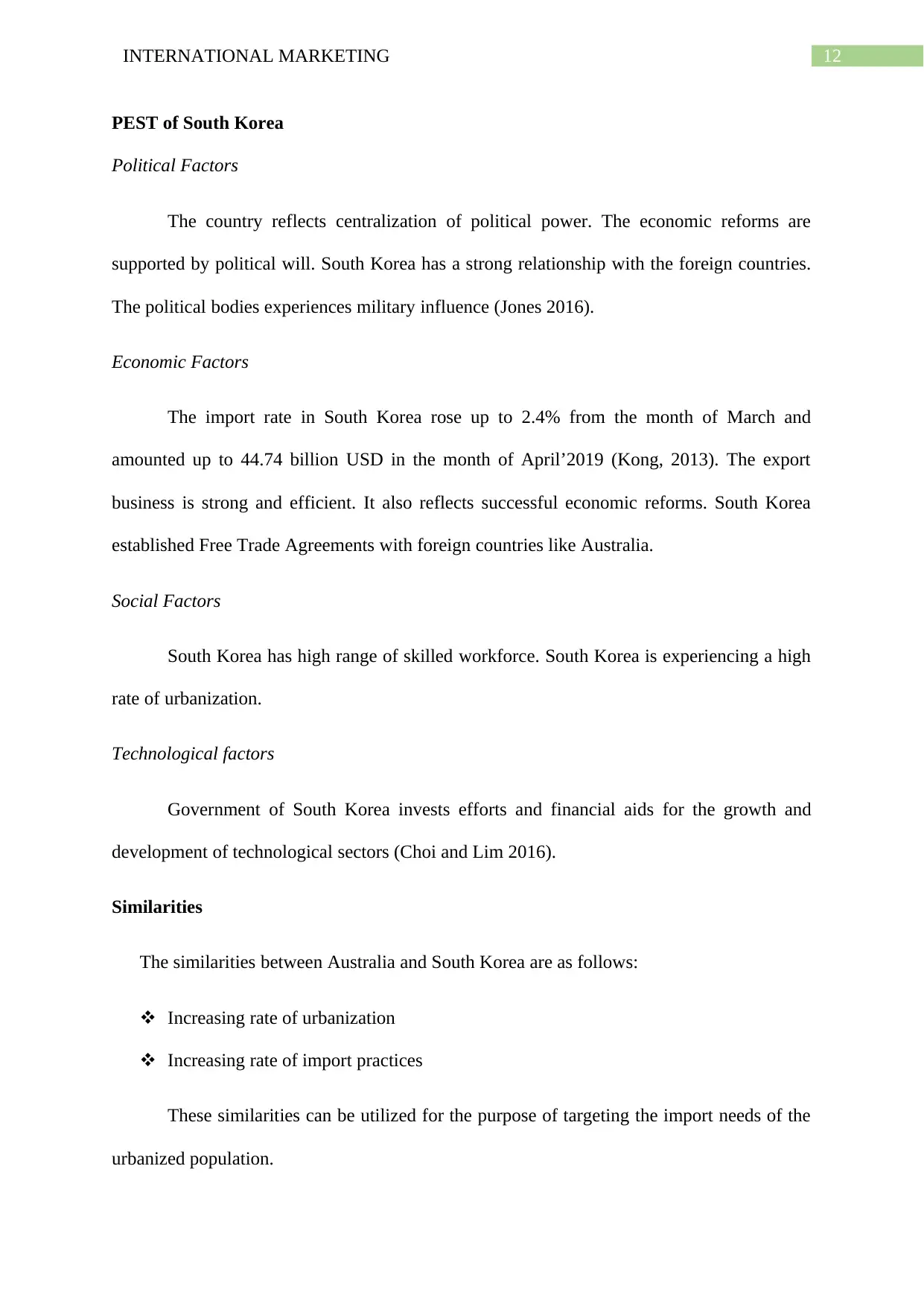
12INTERNATIONAL MARKETING
PEST of South Korea
Political Factors
The country reflects centralization of political power. The economic reforms are
supported by political will. South Korea has a strong relationship with the foreign countries.
The political bodies experiences military influence (Jones 2016).
Economic Factors
The import rate in South Korea rose up to 2.4% from the month of March and
amounted up to 44.74 billion USD in the month of April’2019 (Kong, 2013). The export
business is strong and efficient. It also reflects successful economic reforms. South Korea
established Free Trade Agreements with foreign countries like Australia.
Social Factors
South Korea has high range of skilled workforce. South Korea is experiencing a high
rate of urbanization.
Technological factors
Government of South Korea invests efforts and financial aids for the growth and
development of technological sectors (Choi and Lim 2016).
Similarities
The similarities between Australia and South Korea are as follows:
Increasing rate of urbanization
Increasing rate of import practices
These similarities can be utilized for the purpose of targeting the import needs of the
urbanized population.
PEST of South Korea
Political Factors
The country reflects centralization of political power. The economic reforms are
supported by political will. South Korea has a strong relationship with the foreign countries.
The political bodies experiences military influence (Jones 2016).
Economic Factors
The import rate in South Korea rose up to 2.4% from the month of March and
amounted up to 44.74 billion USD in the month of April’2019 (Kong, 2013). The export
business is strong and efficient. It also reflects successful economic reforms. South Korea
established Free Trade Agreements with foreign countries like Australia.
Social Factors
South Korea has high range of skilled workforce. South Korea is experiencing a high
rate of urbanization.
Technological factors
Government of South Korea invests efforts and financial aids for the growth and
development of technological sectors (Choi and Lim 2016).
Similarities
The similarities between Australia and South Korea are as follows:
Increasing rate of urbanization
Increasing rate of import practices
These similarities can be utilized for the purpose of targeting the import needs of the
urbanized population.
Paraphrase This Document
Need a fresh take? Get an instant paraphrase of this document with our AI Paraphraser
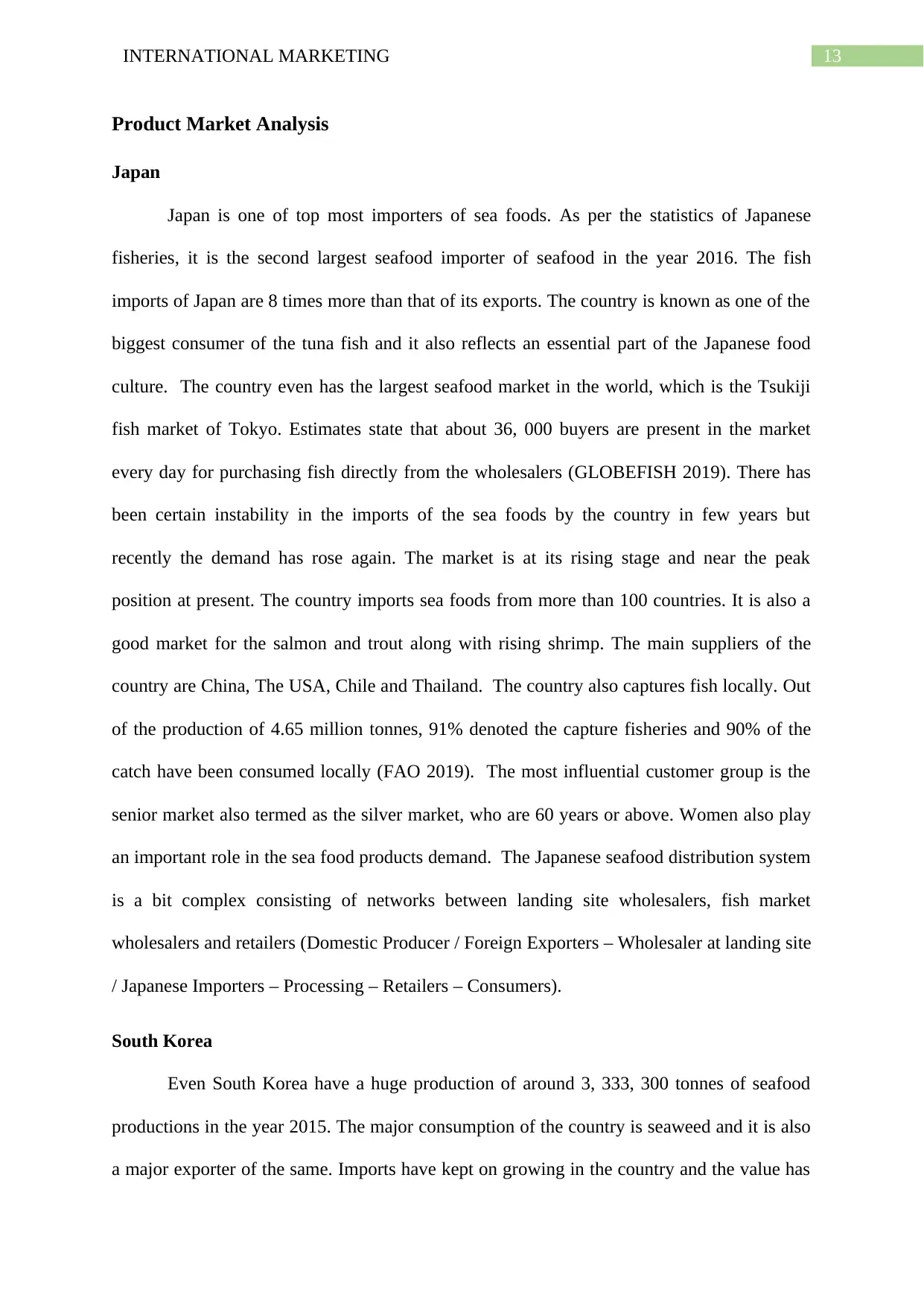
13INTERNATIONAL MARKETING
Product Market Analysis
Japan
Japan is one of top most importers of sea foods. As per the statistics of Japanese
fisheries, it is the second largest seafood importer of seafood in the year 2016. The fish
imports of Japan are 8 times more than that of its exports. The country is known as one of the
biggest consumer of the tuna fish and it also reflects an essential part of the Japanese food
culture. The country even has the largest seafood market in the world, which is the Tsukiji
fish market of Tokyo. Estimates state that about 36, 000 buyers are present in the market
every day for purchasing fish directly from the wholesalers (GLOBEFISH 2019). There has
been certain instability in the imports of the sea foods by the country in few years but
recently the demand has rose again. The market is at its rising stage and near the peak
position at present. The country imports sea foods from more than 100 countries. It is also a
good market for the salmon and trout along with rising shrimp. The main suppliers of the
country are China, The USA, Chile and Thailand. The country also captures fish locally. Out
of the production of 4.65 million tonnes, 91% denoted the capture fisheries and 90% of the
catch have been consumed locally (FAO 2019). The most influential customer group is the
senior market also termed as the silver market, who are 60 years or above. Women also play
an important role in the sea food products demand. The Japanese seafood distribution system
is a bit complex consisting of networks between landing site wholesalers, fish market
wholesalers and retailers (Domestic Producer / Foreign Exporters – Wholesaler at landing site
/ Japanese Importers – Processing – Retailers – Consumers).
South Korea
Even South Korea have a huge production of around 3, 333, 300 tonnes of seafood
productions in the year 2015. The major consumption of the country is seaweed and it is also
a major exporter of the same. Imports have kept on growing in the country and the value has
Product Market Analysis
Japan
Japan is one of top most importers of sea foods. As per the statistics of Japanese
fisheries, it is the second largest seafood importer of seafood in the year 2016. The fish
imports of Japan are 8 times more than that of its exports. The country is known as one of the
biggest consumer of the tuna fish and it also reflects an essential part of the Japanese food
culture. The country even has the largest seafood market in the world, which is the Tsukiji
fish market of Tokyo. Estimates state that about 36, 000 buyers are present in the market
every day for purchasing fish directly from the wholesalers (GLOBEFISH 2019). There has
been certain instability in the imports of the sea foods by the country in few years but
recently the demand has rose again. The market is at its rising stage and near the peak
position at present. The country imports sea foods from more than 100 countries. It is also a
good market for the salmon and trout along with rising shrimp. The main suppliers of the
country are China, The USA, Chile and Thailand. The country also captures fish locally. Out
of the production of 4.65 million tonnes, 91% denoted the capture fisheries and 90% of the
catch have been consumed locally (FAO 2019). The most influential customer group is the
senior market also termed as the silver market, who are 60 years or above. Women also play
an important role in the sea food products demand. The Japanese seafood distribution system
is a bit complex consisting of networks between landing site wholesalers, fish market
wholesalers and retailers (Domestic Producer / Foreign Exporters – Wholesaler at landing site
/ Japanese Importers – Processing – Retailers – Consumers).
South Korea
Even South Korea have a huge production of around 3, 333, 300 tonnes of seafood
productions in the year 2015. The major consumption of the country is seaweed and it is also
a major exporter of the same. Imports have kept on growing in the country and the value has
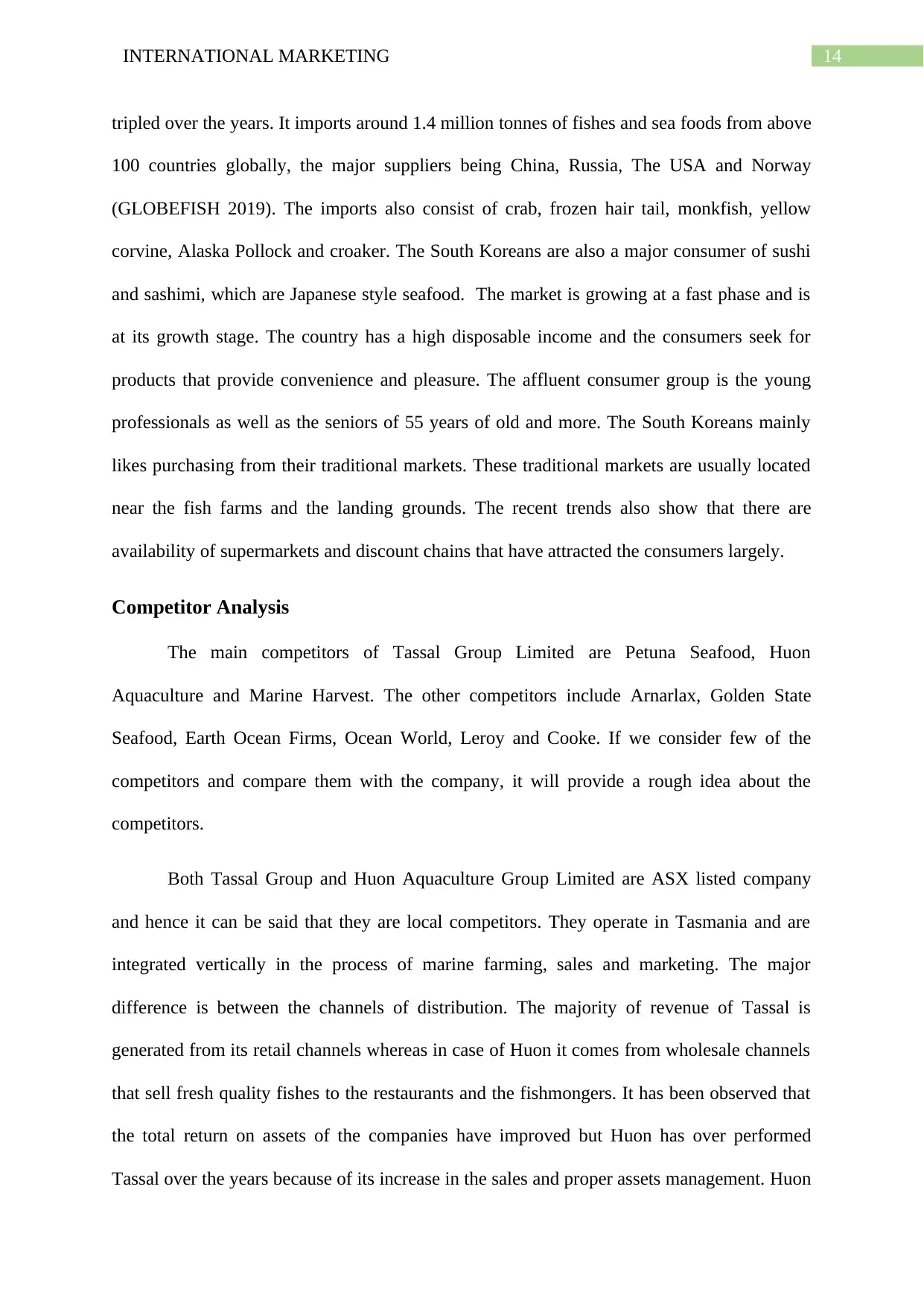
14INTERNATIONAL MARKETING
tripled over the years. It imports around 1.4 million tonnes of fishes and sea foods from above
100 countries globally, the major suppliers being China, Russia, The USA and Norway
(GLOBEFISH 2019). The imports also consist of crab, frozen hair tail, monkfish, yellow
corvine, Alaska Pollock and croaker. The South Koreans are also a major consumer of sushi
and sashimi, which are Japanese style seafood. The market is growing at a fast phase and is
at its growth stage. The country has a high disposable income and the consumers seek for
products that provide convenience and pleasure. The affluent consumer group is the young
professionals as well as the seniors of 55 years of old and more. The South Koreans mainly
likes purchasing from their traditional markets. These traditional markets are usually located
near the fish farms and the landing grounds. The recent trends also show that there are
availability of supermarkets and discount chains that have attracted the consumers largely.
Competitor Analysis
The main competitors of Tassal Group Limited are Petuna Seafood, Huon
Aquaculture and Marine Harvest. The other competitors include Arnarlax, Golden State
Seafood, Earth Ocean Firms, Ocean World, Leroy and Cooke. If we consider few of the
competitors and compare them with the company, it will provide a rough idea about the
competitors.
Both Tassal Group and Huon Aquaculture Group Limited are ASX listed company
and hence it can be said that they are local competitors. They operate in Tasmania and are
integrated vertically in the process of marine farming, sales and marketing. The major
difference is between the channels of distribution. The majority of revenue of Tassal is
generated from its retail channels whereas in case of Huon it comes from wholesale channels
that sell fresh quality fishes to the restaurants and the fishmongers. It has been observed that
the total return on assets of the companies have improved but Huon has over performed
Tassal over the years because of its increase in the sales and proper assets management. Huon
tripled over the years. It imports around 1.4 million tonnes of fishes and sea foods from above
100 countries globally, the major suppliers being China, Russia, The USA and Norway
(GLOBEFISH 2019). The imports also consist of crab, frozen hair tail, monkfish, yellow
corvine, Alaska Pollock and croaker. The South Koreans are also a major consumer of sushi
and sashimi, which are Japanese style seafood. The market is growing at a fast phase and is
at its growth stage. The country has a high disposable income and the consumers seek for
products that provide convenience and pleasure. The affluent consumer group is the young
professionals as well as the seniors of 55 years of old and more. The South Koreans mainly
likes purchasing from their traditional markets. These traditional markets are usually located
near the fish farms and the landing grounds. The recent trends also show that there are
availability of supermarkets and discount chains that have attracted the consumers largely.
Competitor Analysis
The main competitors of Tassal Group Limited are Petuna Seafood, Huon
Aquaculture and Marine Harvest. The other competitors include Arnarlax, Golden State
Seafood, Earth Ocean Firms, Ocean World, Leroy and Cooke. If we consider few of the
competitors and compare them with the company, it will provide a rough idea about the
competitors.
Both Tassal Group and Huon Aquaculture Group Limited are ASX listed company
and hence it can be said that they are local competitors. They operate in Tasmania and are
integrated vertically in the process of marine farming, sales and marketing. The major
difference is between the channels of distribution. The majority of revenue of Tassal is
generated from its retail channels whereas in case of Huon it comes from wholesale channels
that sell fresh quality fishes to the restaurants and the fishmongers. It has been observed that
the total return on assets of the companies have improved but Huon has over performed
Tassal over the years because of its increase in the sales and proper assets management. Huon
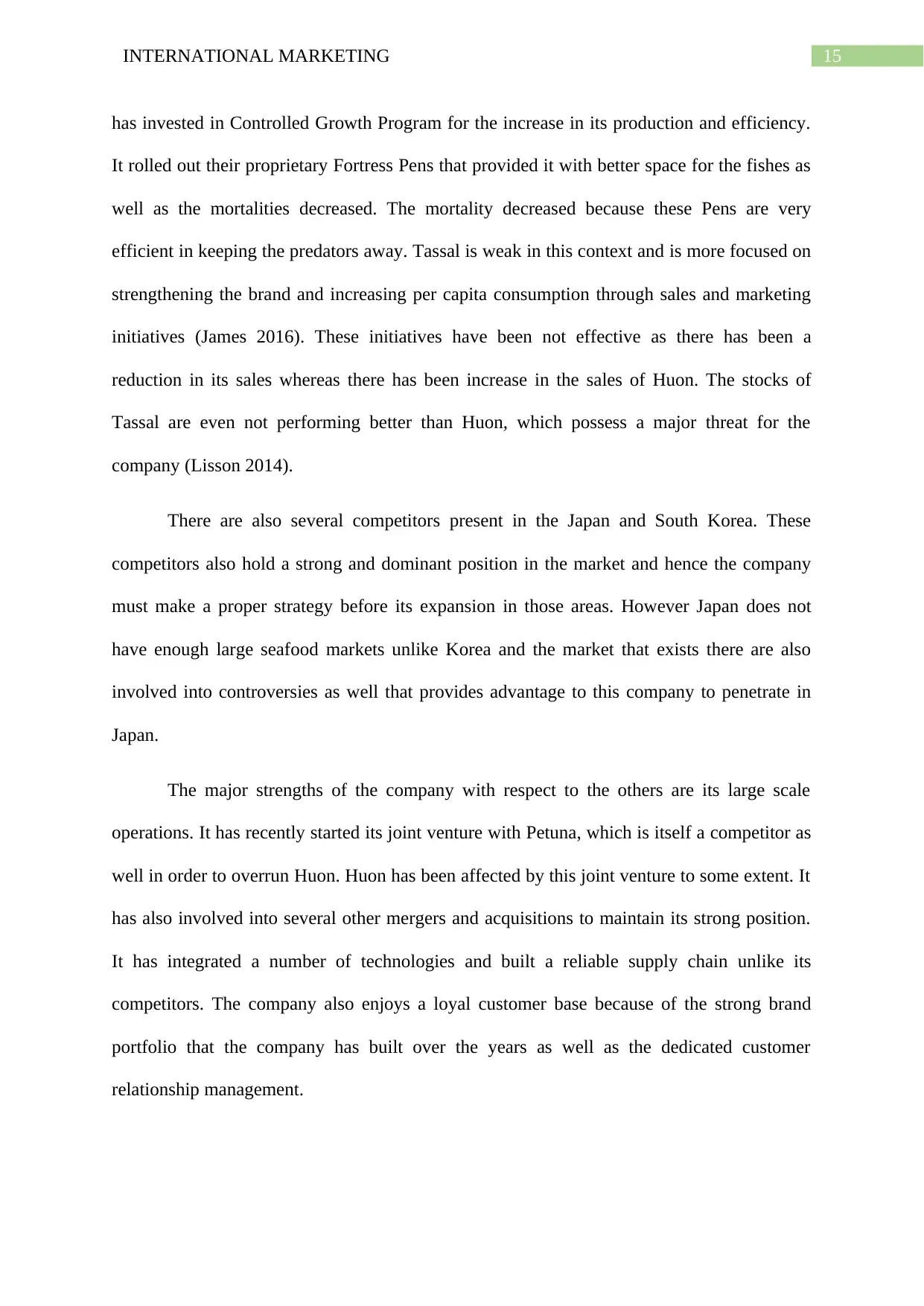
15INTERNATIONAL MARKETING
has invested in Controlled Growth Program for the increase in its production and efficiency.
It rolled out their proprietary Fortress Pens that provided it with better space for the fishes as
well as the mortalities decreased. The mortality decreased because these Pens are very
efficient in keeping the predators away. Tassal is weak in this context and is more focused on
strengthening the brand and increasing per capita consumption through sales and marketing
initiatives (James 2016). These initiatives have been not effective as there has been a
reduction in its sales whereas there has been increase in the sales of Huon. The stocks of
Tassal are even not performing better than Huon, which possess a major threat for the
company (Lisson 2014).
There are also several competitors present in the Japan and South Korea. These
competitors also hold a strong and dominant position in the market and hence the company
must make a proper strategy before its expansion in those areas. However Japan does not
have enough large seafood markets unlike Korea and the market that exists there are also
involved into controversies as well that provides advantage to this company to penetrate in
Japan.
The major strengths of the company with respect to the others are its large scale
operations. It has recently started its joint venture with Petuna, which is itself a competitor as
well in order to overrun Huon. Huon has been affected by this joint venture to some extent. It
has also involved into several other mergers and acquisitions to maintain its strong position.
It has integrated a number of technologies and built a reliable supply chain unlike its
competitors. The company also enjoys a loyal customer base because of the strong brand
portfolio that the company has built over the years as well as the dedicated customer
relationship management.
has invested in Controlled Growth Program for the increase in its production and efficiency.
It rolled out their proprietary Fortress Pens that provided it with better space for the fishes as
well as the mortalities decreased. The mortality decreased because these Pens are very
efficient in keeping the predators away. Tassal is weak in this context and is more focused on
strengthening the brand and increasing per capita consumption through sales and marketing
initiatives (James 2016). These initiatives have been not effective as there has been a
reduction in its sales whereas there has been increase in the sales of Huon. The stocks of
Tassal are even not performing better than Huon, which possess a major threat for the
company (Lisson 2014).
There are also several competitors present in the Japan and South Korea. These
competitors also hold a strong and dominant position in the market and hence the company
must make a proper strategy before its expansion in those areas. However Japan does not
have enough large seafood markets unlike Korea and the market that exists there are also
involved into controversies as well that provides advantage to this company to penetrate in
Japan.
The major strengths of the company with respect to the others are its large scale
operations. It has recently started its joint venture with Petuna, which is itself a competitor as
well in order to overrun Huon. Huon has been affected by this joint venture to some extent. It
has also involved into several other mergers and acquisitions to maintain its strong position.
It has integrated a number of technologies and built a reliable supply chain unlike its
competitors. The company also enjoys a loyal customer base because of the strong brand
portfolio that the company has built over the years as well as the dedicated customer
relationship management.
Secure Best Marks with AI Grader
Need help grading? Try our AI Grader for instant feedback on your assignments.
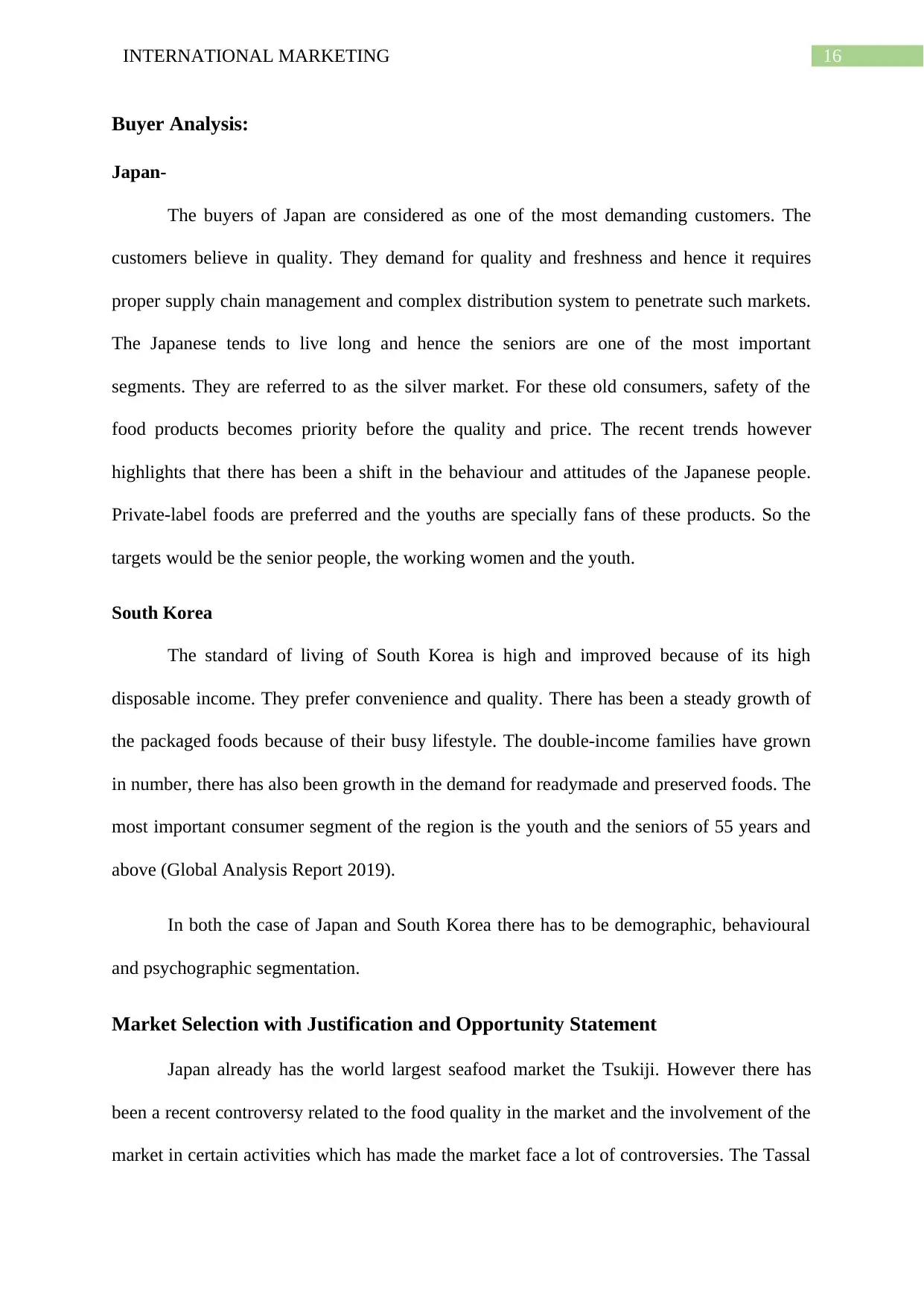
16INTERNATIONAL MARKETING
Buyer Analysis:
Japan-
The buyers of Japan are considered as one of the most demanding customers. The
customers believe in quality. They demand for quality and freshness and hence it requires
proper supply chain management and complex distribution system to penetrate such markets.
The Japanese tends to live long and hence the seniors are one of the most important
segments. They are referred to as the silver market. For these old consumers, safety of the
food products becomes priority before the quality and price. The recent trends however
highlights that there has been a shift in the behaviour and attitudes of the Japanese people.
Private-label foods are preferred and the youths are specially fans of these products. So the
targets would be the senior people, the working women and the youth.
South Korea
The standard of living of South Korea is high and improved because of its high
disposable income. They prefer convenience and quality. There has been a steady growth of
the packaged foods because of their busy lifestyle. The double-income families have grown
in number, there has also been growth in the demand for readymade and preserved foods. The
most important consumer segment of the region is the youth and the seniors of 55 years and
above (Global Analysis Report 2019).
In both the case of Japan and South Korea there has to be demographic, behavioural
and psychographic segmentation.
Market Selection with Justification and Opportunity Statement
Japan already has the world largest seafood market the Tsukiji. However there has
been a recent controversy related to the food quality in the market and the involvement of the
market in certain activities which has made the market face a lot of controversies. The Tassal
Buyer Analysis:
Japan-
The buyers of Japan are considered as one of the most demanding customers. The
customers believe in quality. They demand for quality and freshness and hence it requires
proper supply chain management and complex distribution system to penetrate such markets.
The Japanese tends to live long and hence the seniors are one of the most important
segments. They are referred to as the silver market. For these old consumers, safety of the
food products becomes priority before the quality and price. The recent trends however
highlights that there has been a shift in the behaviour and attitudes of the Japanese people.
Private-label foods are preferred and the youths are specially fans of these products. So the
targets would be the senior people, the working women and the youth.
South Korea
The standard of living of South Korea is high and improved because of its high
disposable income. They prefer convenience and quality. There has been a steady growth of
the packaged foods because of their busy lifestyle. The double-income families have grown
in number, there has also been growth in the demand for readymade and preserved foods. The
most important consumer segment of the region is the youth and the seniors of 55 years and
above (Global Analysis Report 2019).
In both the case of Japan and South Korea there has to be demographic, behavioural
and psychographic segmentation.
Market Selection with Justification and Opportunity Statement
Japan already has the world largest seafood market the Tsukiji. However there has
been a recent controversy related to the food quality in the market and the involvement of the
market in certain activities which has made the market face a lot of controversies. The Tassal
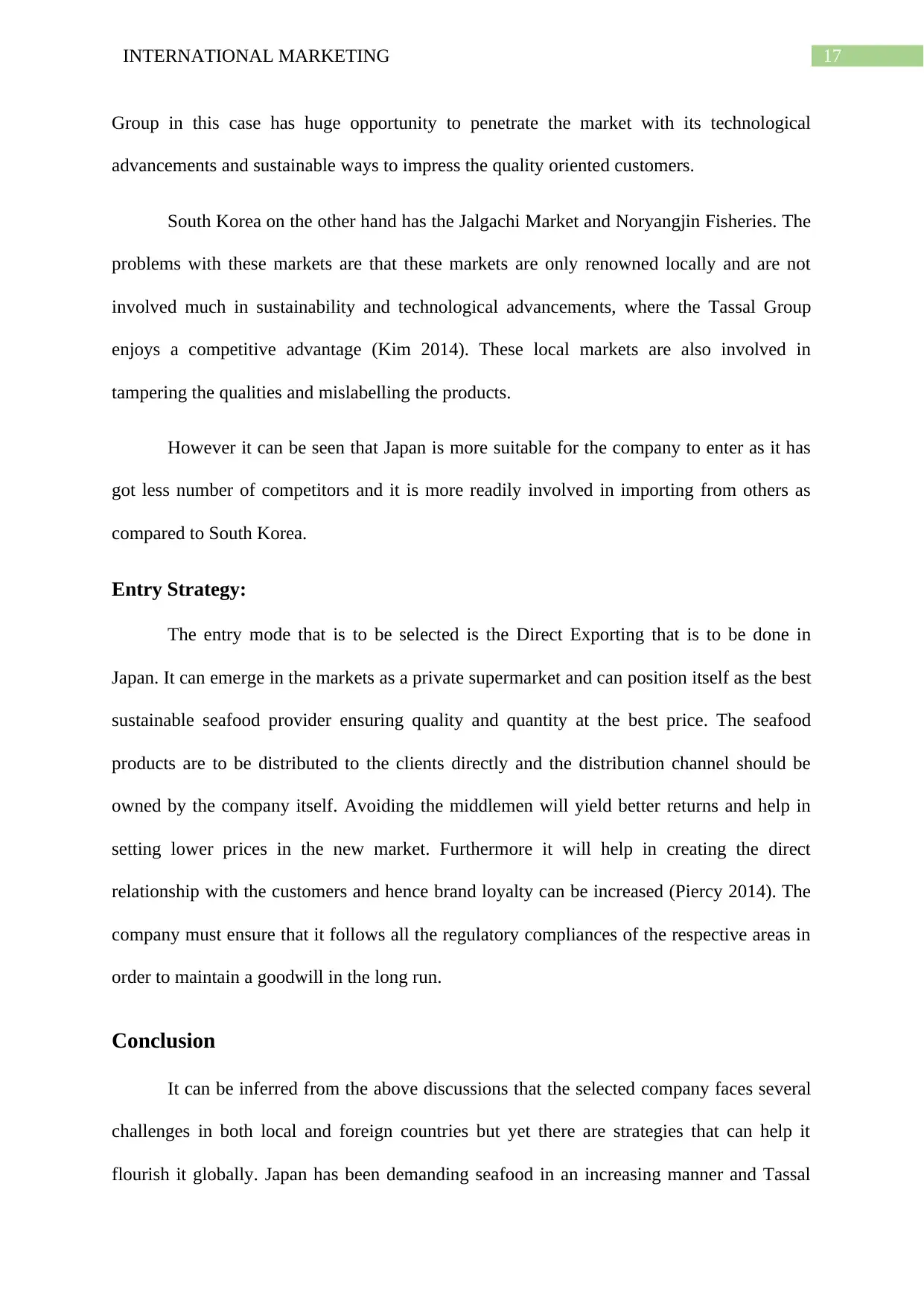
17INTERNATIONAL MARKETING
Group in this case has huge opportunity to penetrate the market with its technological
advancements and sustainable ways to impress the quality oriented customers.
South Korea on the other hand has the Jalgachi Market and Noryangjin Fisheries. The
problems with these markets are that these markets are only renowned locally and are not
involved much in sustainability and technological advancements, where the Tassal Group
enjoys a competitive advantage (Kim 2014). These local markets are also involved in
tampering the qualities and mislabelling the products.
However it can be seen that Japan is more suitable for the company to enter as it has
got less number of competitors and it is more readily involved in importing from others as
compared to South Korea.
Entry Strategy:
The entry mode that is to be selected is the Direct Exporting that is to be done in
Japan. It can emerge in the markets as a private supermarket and can position itself as the best
sustainable seafood provider ensuring quality and quantity at the best price. The seafood
products are to be distributed to the clients directly and the distribution channel should be
owned by the company itself. Avoiding the middlemen will yield better returns and help in
setting lower prices in the new market. Furthermore it will help in creating the direct
relationship with the customers and hence brand loyalty can be increased (Piercy 2014). The
company must ensure that it follows all the regulatory compliances of the respective areas in
order to maintain a goodwill in the long run.
Conclusion
It can be inferred from the above discussions that the selected company faces several
challenges in both local and foreign countries but yet there are strategies that can help it
flourish it globally. Japan has been demanding seafood in an increasing manner and Tassal
Group in this case has huge opportunity to penetrate the market with its technological
advancements and sustainable ways to impress the quality oriented customers.
South Korea on the other hand has the Jalgachi Market and Noryangjin Fisheries. The
problems with these markets are that these markets are only renowned locally and are not
involved much in sustainability and technological advancements, where the Tassal Group
enjoys a competitive advantage (Kim 2014). These local markets are also involved in
tampering the qualities and mislabelling the products.
However it can be seen that Japan is more suitable for the company to enter as it has
got less number of competitors and it is more readily involved in importing from others as
compared to South Korea.
Entry Strategy:
The entry mode that is to be selected is the Direct Exporting that is to be done in
Japan. It can emerge in the markets as a private supermarket and can position itself as the best
sustainable seafood provider ensuring quality and quantity at the best price. The seafood
products are to be distributed to the clients directly and the distribution channel should be
owned by the company itself. Avoiding the middlemen will yield better returns and help in
setting lower prices in the new market. Furthermore it will help in creating the direct
relationship with the customers and hence brand loyalty can be increased (Piercy 2014). The
company must ensure that it follows all the regulatory compliances of the respective areas in
order to maintain a goodwill in the long run.
Conclusion
It can be inferred from the above discussions that the selected company faces several
challenges in both local and foreign countries but yet there are strategies that can help it
flourish it globally. Japan has been demanding seafood in an increasing manner and Tassal
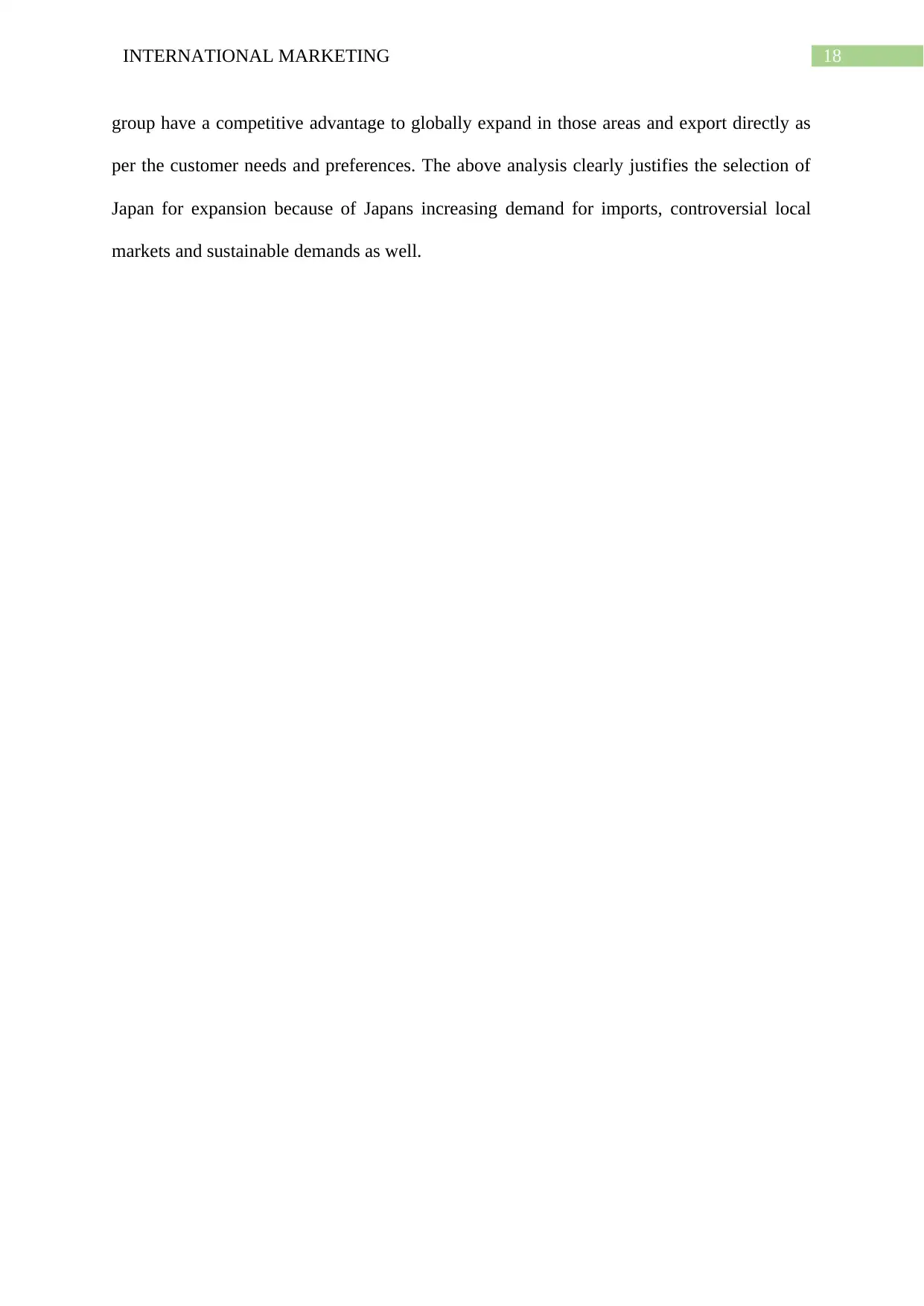
18INTERNATIONAL MARKETING
group have a competitive advantage to globally expand in those areas and export directly as
per the customer needs and preferences. The above analysis clearly justifies the selection of
Japan for expansion because of Japans increasing demand for imports, controversial local
markets and sustainable demands as well.
group have a competitive advantage to globally expand in those areas and export directly as
per the customer needs and preferences. The above analysis clearly justifies the selection of
Japan for expansion because of Japans increasing demand for imports, controversial local
markets and sustainable demands as well.
Paraphrase This Document
Need a fresh take? Get an instant paraphrase of this document with our AI Paraphraser
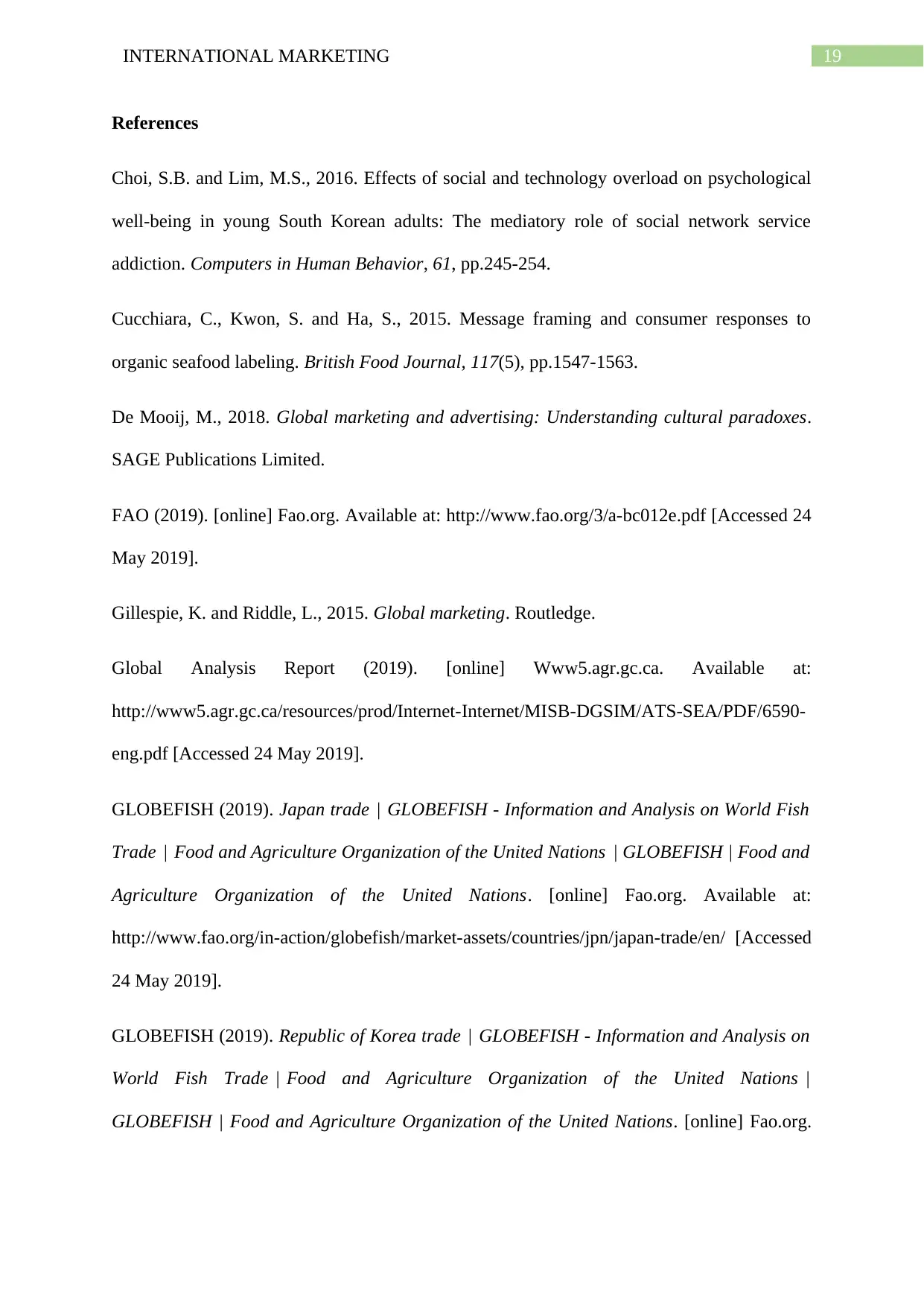
19INTERNATIONAL MARKETING
References
Choi, S.B. and Lim, M.S., 2016. Effects of social and technology overload on psychological
well-being in young South Korean adults: The mediatory role of social network service
addiction. Computers in Human Behavior, 61, pp.245-254.
Cucchiara, C., Kwon, S. and Ha, S., 2015. Message framing and consumer responses to
organic seafood labeling. British Food Journal, 117(5), pp.1547-1563.
De Mooij, M., 2018. Global marketing and advertising: Understanding cultural paradoxes.
SAGE Publications Limited.
FAO (2019). [online] Fao.org. Available at: http://www.fao.org/3/a-bc012e.pdf [Accessed 24
May 2019].
Gillespie, K. and Riddle, L., 2015. Global marketing. Routledge.
Global Analysis Report (2019). [online] Www5.agr.gc.ca. Available at:
http://www5.agr.gc.ca/resources/prod/Internet-Internet/MISB-DGSIM/ATS-SEA/PDF/6590-
eng.pdf [Accessed 24 May 2019].
GLOBEFISH (2019). Japan trade | GLOBEFISH - Information and Analysis on World Fish
Trade | Food and Agriculture Organization of the United Nations | GLOBEFISH | Food and
Agriculture Organization of the United Nations. [online] Fao.org. Available at:
http://www.fao.org/in-action/globefish/market-assets/countries/jpn/japan-trade/en/ [Accessed
24 May 2019].
GLOBEFISH (2019). Republic of Korea trade | GLOBEFISH - Information and Analysis on
World Fish Trade | Food and Agriculture Organization of the United Nations |
GLOBEFISH | Food and Agriculture Organization of the United Nations. [online] Fao.org.
References
Choi, S.B. and Lim, M.S., 2016. Effects of social and technology overload on psychological
well-being in young South Korean adults: The mediatory role of social network service
addiction. Computers in Human Behavior, 61, pp.245-254.
Cucchiara, C., Kwon, S. and Ha, S., 2015. Message framing and consumer responses to
organic seafood labeling. British Food Journal, 117(5), pp.1547-1563.
De Mooij, M., 2018. Global marketing and advertising: Understanding cultural paradoxes.
SAGE Publications Limited.
FAO (2019). [online] Fao.org. Available at: http://www.fao.org/3/a-bc012e.pdf [Accessed 24
May 2019].
Gillespie, K. and Riddle, L., 2015. Global marketing. Routledge.
Global Analysis Report (2019). [online] Www5.agr.gc.ca. Available at:
http://www5.agr.gc.ca/resources/prod/Internet-Internet/MISB-DGSIM/ATS-SEA/PDF/6590-
eng.pdf [Accessed 24 May 2019].
GLOBEFISH (2019). Japan trade | GLOBEFISH - Information and Analysis on World Fish
Trade | Food and Agriculture Organization of the United Nations | GLOBEFISH | Food and
Agriculture Organization of the United Nations. [online] Fao.org. Available at:
http://www.fao.org/in-action/globefish/market-assets/countries/jpn/japan-trade/en/ [Accessed
24 May 2019].
GLOBEFISH (2019). Republic of Korea trade | GLOBEFISH - Information and Analysis on
World Fish Trade | Food and Agriculture Organization of the United Nations |
GLOBEFISH | Food and Agriculture Organization of the United Nations. [online] Fao.org.
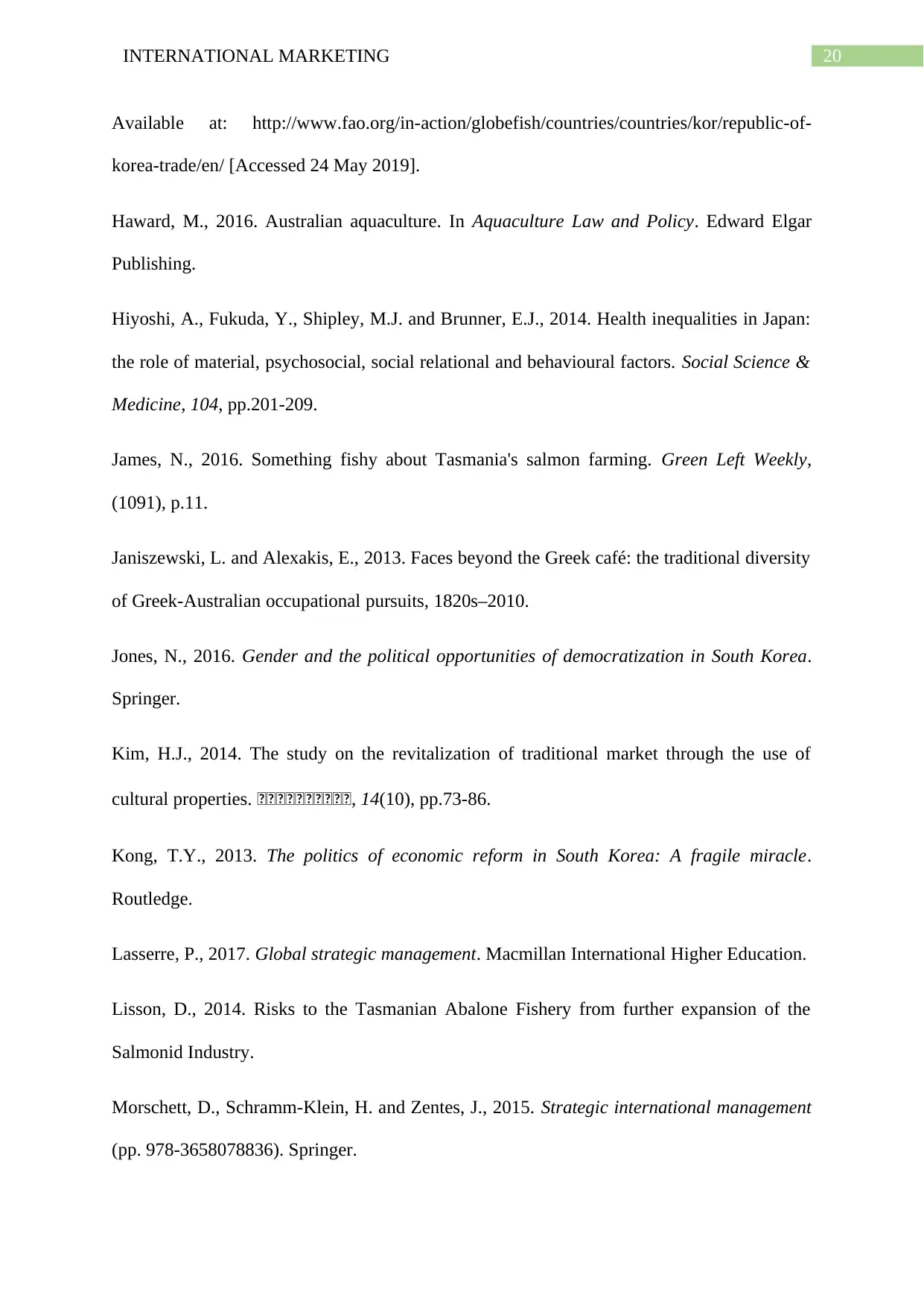
20INTERNATIONAL MARKETING
Available at: http://www.fao.org/in-action/globefish/countries/countries/kor/republic-of-
korea-trade/en/ [Accessed 24 May 2019].
Haward, M., 2016. Australian aquaculture. In Aquaculture Law and Policy. Edward Elgar
Publishing.
Hiyoshi, A., Fukuda, Y., Shipley, M.J. and Brunner, E.J., 2014. Health inequalities in Japan:
the role of material, psychosocial, social relational and behavioural factors. Social Science &
Medicine, 104, pp.201-209.
James, N., 2016. Something fishy about Tasmania's salmon farming. Green Left Weekly,
(1091), p.11.
Janiszewski, L. and Alexakis, E., 2013. Faces beyond the Greek café: the traditional diversity
of Greek-Australian occupational pursuits, 1820s–2010.
Jones, N., 2016. Gender and the political opportunities of democratization in South Korea.
Springer.
Kim, H.J., 2014. The study on the revitalization of traditional market through the use of
cultural properties. 한한한한한한한한한한, 14(10), pp.73-86.
Kong, T.Y., 2013. The politics of economic reform in South Korea: A fragile miracle.
Routledge.
Lasserre, P., 2017. Global strategic management. Macmillan International Higher Education.
Lisson, D., 2014. Risks to the Tasmanian Abalone Fishery from further expansion of the
Salmonid Industry.
Morschett, D., Schramm-Klein, H. and Zentes, J., 2015. Strategic international management
(pp. 978-3658078836). Springer.
Available at: http://www.fao.org/in-action/globefish/countries/countries/kor/republic-of-
korea-trade/en/ [Accessed 24 May 2019].
Haward, M., 2016. Australian aquaculture. In Aquaculture Law and Policy. Edward Elgar
Publishing.
Hiyoshi, A., Fukuda, Y., Shipley, M.J. and Brunner, E.J., 2014. Health inequalities in Japan:
the role of material, psychosocial, social relational and behavioural factors. Social Science &
Medicine, 104, pp.201-209.
James, N., 2016. Something fishy about Tasmania's salmon farming. Green Left Weekly,
(1091), p.11.
Janiszewski, L. and Alexakis, E., 2013. Faces beyond the Greek café: the traditional diversity
of Greek-Australian occupational pursuits, 1820s–2010.
Jones, N., 2016. Gender and the political opportunities of democratization in South Korea.
Springer.
Kim, H.J., 2014. The study on the revitalization of traditional market through the use of
cultural properties. 한한한한한한한한한한, 14(10), pp.73-86.
Kong, T.Y., 2013. The politics of economic reform in South Korea: A fragile miracle.
Routledge.
Lasserre, P., 2017. Global strategic management. Macmillan International Higher Education.
Lisson, D., 2014. Risks to the Tasmanian Abalone Fishery from further expansion of the
Salmonid Industry.
Morschett, D., Schramm-Klein, H. and Zentes, J., 2015. Strategic international management
(pp. 978-3658078836). Springer.
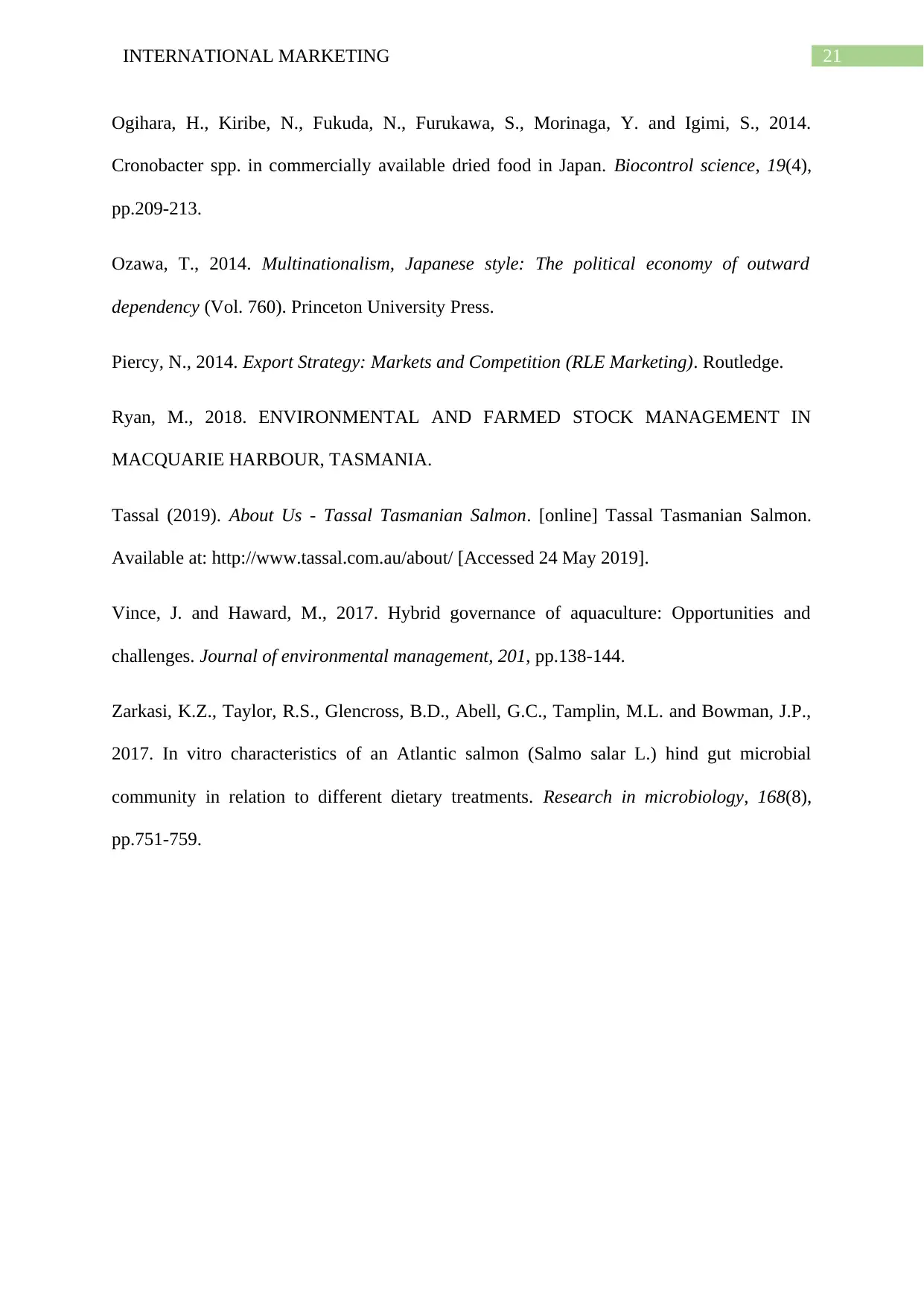
21INTERNATIONAL MARKETING
Ogihara, H., Kiribe, N., Fukuda, N., Furukawa, S., Morinaga, Y. and Igimi, S., 2014.
Cronobacter spp. in commercially available dried food in Japan. Biocontrol science, 19(4),
pp.209-213.
Ozawa, T., 2014. Multinationalism, Japanese style: The political economy of outward
dependency (Vol. 760). Princeton University Press.
Piercy, N., 2014. Export Strategy: Markets and Competition (RLE Marketing). Routledge.
Ryan, M., 2018. ENVIRONMENTAL AND FARMED STOCK MANAGEMENT IN
MACQUARIE HARBOUR, TASMANIA.
Tassal (2019). About Us - Tassal Tasmanian Salmon. [online] Tassal Tasmanian Salmon.
Available at: http://www.tassal.com.au/about/ [Accessed 24 May 2019].
Vince, J. and Haward, M., 2017. Hybrid governance of aquaculture: Opportunities and
challenges. Journal of environmental management, 201, pp.138-144.
Zarkasi, K.Z., Taylor, R.S., Glencross, B.D., Abell, G.C., Tamplin, M.L. and Bowman, J.P.,
2017. In vitro characteristics of an Atlantic salmon (Salmo salar L.) hind gut microbial
community in relation to different dietary treatments. Research in microbiology, 168(8),
pp.751-759.
Ogihara, H., Kiribe, N., Fukuda, N., Furukawa, S., Morinaga, Y. and Igimi, S., 2014.
Cronobacter spp. in commercially available dried food in Japan. Biocontrol science, 19(4),
pp.209-213.
Ozawa, T., 2014. Multinationalism, Japanese style: The political economy of outward
dependency (Vol. 760). Princeton University Press.
Piercy, N., 2014. Export Strategy: Markets and Competition (RLE Marketing). Routledge.
Ryan, M., 2018. ENVIRONMENTAL AND FARMED STOCK MANAGEMENT IN
MACQUARIE HARBOUR, TASMANIA.
Tassal (2019). About Us - Tassal Tasmanian Salmon. [online] Tassal Tasmanian Salmon.
Available at: http://www.tassal.com.au/about/ [Accessed 24 May 2019].
Vince, J. and Haward, M., 2017. Hybrid governance of aquaculture: Opportunities and
challenges. Journal of environmental management, 201, pp.138-144.
Zarkasi, K.Z., Taylor, R.S., Glencross, B.D., Abell, G.C., Tamplin, M.L. and Bowman, J.P.,
2017. In vitro characteristics of an Atlantic salmon (Salmo salar L.) hind gut microbial
community in relation to different dietary treatments. Research in microbiology, 168(8),
pp.751-759.
1 out of 22
Related Documents
Your All-in-One AI-Powered Toolkit for Academic Success.
+13062052269
info@desklib.com
Available 24*7 on WhatsApp / Email
![[object Object]](/_next/static/media/star-bottom.7253800d.svg)
Unlock your academic potential
© 2024 | Zucol Services PVT LTD | All rights reserved.





